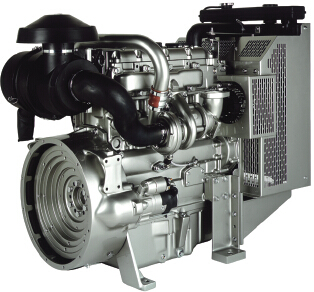详细描述
Operation and
Maintenance
Manual
1103D Industrial Engine
XK (Engine)
XL (Engine)
XM (Engine)
This document has been printed from SPI². Not for Resale
![]()
![]()
![]()
![]()
![]()
Important Safety Information
Most accidents tha t involve produc t op eration, ma intena nc e and repair are caus ed by failure to
ob serve basic safety rules or precautions . An accident can often be avoided by recog nizing pote ntially
ha za rdous situations before an accident oc curs . A person mus t be alert to pote ntial ha za rds. This
person should also ha ve the ne cessary training, skills and tools to perform the se func tions properly.
Improper operation, lubrication, maintenance or repair of this product can be dangerous and
could result in injury or death.
Do not operate or perform any lubrication, maintenance or repair on this product, until you have
read and understood the operation, lubrication, maintenance and repair information.
Sa fety precautions and warning s are provided in this ma nua l and on the produc t. If the se ha za rd
warning s are not he eded, bod ily injury or death could oc cur to you or to othe r persons .
The ha za rds are identified by the “Safety Alert Symb ol” and followed by a “Signa l Word” suc h as
“DANGER”, “WARNING” or “CAUTION”. The Sa fety Alert “WARNING” label is shown below.
The me aning of this safety alert symb ol is as follows:
Attention! Become Alert! Your Safety is Involved.
The me ssage tha t appears und er the warning explains the ha za rd and can be either written or
pictorially presente d.
Op erations tha t ma y caus e produc t dama ge are identified by “NOTICE” labels on the produc t and in
this pub lication.
Perkins cannot anticipate every possible circumstance that might involve a potential hazard. The
warnings in this publication and on the product are, therefore, not all inclusive. If a tool, procedure,
work method or operating technique that is not specifically recommended by Perkins is used,
you must satisfy yourself that it is safe for you and for others. You should also ensure that the
product will not be damaged or be made unsafe by the operation, lubrication, maintenance or
repair procedures that you choose.
The informa tion, specifications , and illustrations in this pub lication are on the basis of informa tion tha t
was available at the time tha t the pub lication was written. The specifications , torque s, pressure s,
me asure me nts , adjustme nts , illustrations , and othe r items can cha ng e at any time. These cha ng es can
affect the service tha t is given to the produc t. Ob tain the comp lete and mos t current informa tion before
you start any job. Pe rkins dealers or Pe rkins distributors ha ve the mos t current informa tion available.
When replacement parts are required for this
product Perkins recommends using Perkins
replacement parts.
Failure to heed this warning can lead to prema-
ture failures, product damage, personal injury or
death.
This document has been printed from SPI². Not for Resale
![]()
![]()
SEBU8352
3
Table of Contents
Table of Contents
Index Section
Index ..................................................................... 73
Foreword ................................................................. 4
Safety Section
Safety Messages .................................................... 5
General Hazard Information ................................... 6
Burn Prevention ...................................................... 8
Fire Prevention and Explosion Prevention .............. 8
Crushing Prevention and Cutting Prevention ........ 10
Mounting and Dismounting ................................... 10
Before Starting Engine .......................................... 10
Engine Starting ...................................................... 11
Engine Stopping .................................................... 11
Electrical System ................................................... 11
Product Information Section
Model Views ......................................................... 13
Product Identification Information ........................ 16
Operation Section
Lifting and Storage ................................................ 19
Gauges and Indicators .......................................... 22
Features and Controls .......................................... 23
Engine Starting ..................................................... 24
Engine Operation .................................................. 27
Engine Stopping ................................................... 28
Cold Weather Operation ....................................... 29
Maintenance Section
Refill Capacities .................................................... 33
Maintenance Interval Schedule ............................ 46
Warranty Section
Warranty Information ............................................ 72
This document has been printed from SPI². Not for Resale
![]()
![]()
4
SEBU8352
Foreword
Foreword
Recommended service should be performed at the
appropriate intervals as indicated in the Maintenance
Interval Schedule. The actual operating environment
of the engine also governs the Maintenance Interval
Schedule. Therefore, under extremely severe,
dusty, wet or freezing cold operating conditions,
more frequent lubrication and maintenance than is
specified in the Maintenance Interval Schedule may
be necessary.
Literature Information
This manual contains safety, operation instructions,
lubrication and maintenance information. This
manual should be stored in or near the engine area
in a literature holder or literature storage area. Read,
study and keep it with the literature and engine
information.
The maintenance schedule items are organized for
a preventive maintenance management program. If
the preventive maintenance program is followed, a
periodic tune-up is not required. The implementation
of a preventive maintenance management program
should minimize operating costs through cost
avoidances resulting from reductions in unscheduled
downtime and failures.
English is the primary language for all Perkins
publications. The English used facilitates translation
and consistency.
Some photographs or illustrations in this manual
show details or attachments that may be different
from your engine. Guards and covers may have
been removed for illustrative purposes. Continuing
improvement and advancement of product design
may have caused changes to your engine which are
not included in this manual. Whenever a question
arises regarding your engine, or this manual, please
consult with your Perkins dealer or your Perkins
distributor for the latest available information.
Maintenance Intervals
Perform maintenance on items at multiples of
the original requirement. We recommend that the
maintenance schedules be reproduced and displayed
near the engine as a convenient reminder. We also
recommend that a maintenance record be maintained
as part of the engine’s permanent record.
Safety
Your authorized Perkins dealer or your Perkins
distributor can assist you in adjusting your
maintenance schedule to meet the needs of your
operating environment.
This safety section lists basic safety precautions.
In addition, this section identifies hazardous,
warning situations. Read and understand the basic
precautions listed in the safety section before
operating or performing lubrication, maintenance and
repair on this product.
Overhaul
Major engine overhaul details are not covered in
the Operation and Maintenance Manual except
for the interval and the maintenance items in that
interval. Major repairs should only be carried out by
Perkins authorized personnel. Your Perkins dealer
or your Perkins distributor offers a variety of options
regarding overhaul programs. If you experience
a major engine failure, there are also numerous
after failure overhaul options available. Consult with
your Perkins dealer or your Perkins distributor for
information regarding these options.
Operation
Operating techniques outlined in this manual are
basic. They assist with developing the skills and
techniques required to operate the engine more
efficiently and economically. Skill and techniques
develop as the operator gains knowledge of the
engine and its capabilities.
The operation section is a reference for operators.
Photographs and illustrations guide the operator
through procedures of inspecting, starting, operating
and stopping the engine. This section also includes a
discussion of electronic diagnostic information.
California Proposition 65 Warning
Diesel engine exhaust and some of its constituents
are known to the State of California to cause cancer,
birth defects, and other reproductive harm. Battery
posts, terminals and related accessories contain lead
and lead compounds. Wash hands after handling.
Maintenance
The maintenance section is a guide to engine care.
The illustrated, step-by-step instructions are grouped
by service hours and/or calendar time maintenance
intervals. Items in the maintenance schedule are
referenced to detailed instructions that follow.
This document has been printed from SPI². Not for Resale
![]()
SEBU8352
5
Safety Section
Safety Messages
Safety Section
i02811420
Safety Messages
There may be several specific warning signs on your
engine. The exact location and a description of the
warning signs are reviewed in this section. Please
become familiar with all warning signs.
Ensure that all of the warning signs are legible. Clean
the warning signs or replace the warning signs if
the words cannot be read or if the illustrations are
not visible. Use a cloth, water, and soap to clean
the warning signs. Do not use solvents, gasoline, or
other harsh chemicals. Solvents, gasoline, or harsh
chemicals could loosen the adhesive that secures the
warning signs. The warning signs that are loosened
could drop off of the engine.
Replace any warning sign that is damaged or
missing. If a warning sign is attached to a part of the
engine that is replaced, install a new warning sign on
the replacement part. Your Perkins dealer or your
distributor can provide new warning signs.
(1) Universal Warning
Do not operate or work on this equipment unless
you have read and understand the instructions
and warnings in the Operation and Maintenance
Manuals. Failure to follow the instructions or
heed the warnings could result in serious injury
or death.
g01154807
Illustration 1
Typical example
The Universal Warning label (2) is located on the rear
end of the inlet manifold cover. Refer to illustration 2.
This document has been printed from SPI². Not for Resale
![]()
![]()
![]()
![]()
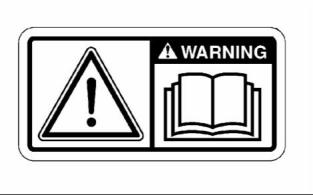
![]()
6
SEBU8352
Safety Section
General Hazard Information
g01431463
i02328435
Illustration 2
(1) Ether Warning Label
(2) Universal warning
(2) Ether
General Hazard Information
Do not use aerosol types of starting aids such as
ether. Such use could result in an explosion and
personal injury.
g00104545
Illustration 4
Attach a “Do Not Operate” warning tag or a similar
warning tag to the start switch or to the controls
before you service the equipment or before you
repair the equipment.
g01154809
Illustration 3
Typical example
The ether warning label (1) is located on the front
end of the inlet manifold cover. Refer to illustration 2.
This document has been printed from SPI². Not for Resale
![]()
![]()
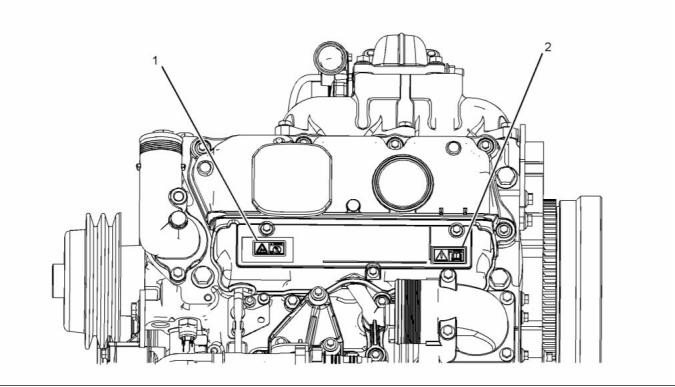
![]()
![]()
![]()
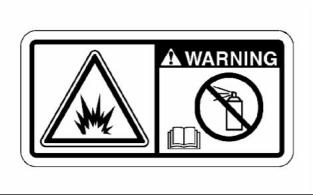
![]()
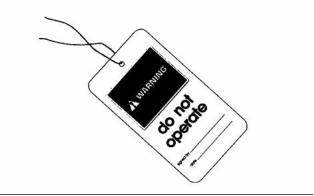
SEBU8352
7
Safety Section
General Hazard Information
When pressurized air and/or water is used for
cleaning, wear protective clothing, protective shoes,
and eye protection. Eye protection includes goggles
or a protective face shield.
The maximum air pressure for cleaning purposes
must be below 205 kPa (30 psi). The maximum
water pressure for cleaning purposes must be below
275 kPa (40 psi).
Fluid Penetration
Pressure can be trapped in the hydraulic circuit long
after the engine has been stopped. The pressure can
cause hydraulic fluid or items such as pipe plugs to
escape rapidly if the pressure is not relieved correctly.
g00702020
Illustration 5
Wear a hard hat, protective glasses, and other
protective equipment, as required.
Do not remove any hydraulic components or parts
until pressure has been relieved or personal injury
may occur. Do not disassemble any hydraulic
components or parts until pressure has been relieved
or personal injury may occur. Refer to the OEM
information for any procedures that are required to
relieve the hydraulic pressure.
Do not wear loose clothing or jewelry that can snag
on controls or on other parts of the engine.
Make sure that all protective guards and all covers
are secured in place on the engine.
Keep the engine free from foreign material. Remove
debris, oil, tools, and other items from the deck, from
walkways, and from steps.
Never put maintenance fluids into glass containers.
Drain all liquids into a suitable container.
Obey all local regulations for the disposal of liquids.
Use all cleaning solutions with care.
Report all necessary repairs.
Do not allow unauthorized personnel on the
equipment.
g00687600
Illustration 6
Always use a board or cardboard when you check
for a leak. Leaking fluid that is under pressure can
penetrate body tissue. Fluid penetration can cause
serious injury and possible death. A pin hole leak can
cause severe injury. If fluid is injected into your skin,
you must get treatment immediately. Seek treatment
from a doctor that is familiar with this type of injury.
Ensure that the power supply is disconnected before
you work on the bus bar or the glow plugs.
Perform maintenance on the engine with the
equipment in the servicing position. Refer to the
OEM information for the procedure for placing the
equipment in the servicing position.
Containing Fluid Spillage
Pressure Air and Water
Care must be taken in order to ensure that fluids
are contained during performance of inspection,
maintenance, testing, adjusting and repair of the
engine. Make provision to collect the fluid with a
suitable container before any compartment is opened
or before any component is disassembled.
Pressurized air and/or water can cause debris
and/or hot water to be blown out. This could result in
personal injury.
The direct application of pressurized air or
pressurized water to the body could result in personal
injury.
• Only use the tools that are suitable for collecting
fluids and equipment that is suitable for collecting
fluids.
This document has been printed from SPI². Not for Resale
![]()
![]()
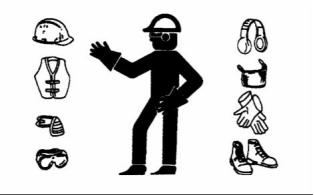
![]()
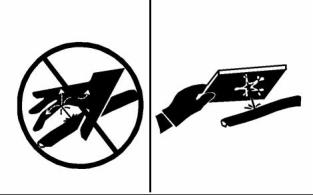
8
SEBU8352
Safety Section
Burn Prevention
• Only use the tools that are suitable for containing
fluids and equipment that is suitable for containing
fluids.
i02813488
Fire Prevention and Explosion
Prevention
Obey all local regulations for the disposal of liquids.
i02143195
Burn Prevention
Do not touch any part of an operating engine.
Allow the engine to cool before any maintenance
is performed on the engine. Relieve all pressure
in the air system, in the hydraulic system, in the
lubrication system, in the fuel system, or in the
cooling system before any lines, fittings or related
items are disconnected.
Coolant
g00704000
Illustration 7
When the engine is at operating temperature, the
engine coolant is hot. The coolant is also under
pressure. The radiator and all lines to the heaters or
to the engine contain hot coolant.
All fuels, most lubricants, and some coolant mixtures
are flammable.
Flammable fluids that are leaking or spilled onto hot
surfaces or onto electrical components can cause
a fire. Fire may cause personal injury and property
damage.
Any contact with hot coolant or with steam can cause
severe burns. Allow cooling system components to
cool before the cooling system is drained.
A flash fire may result if the covers for the engine
crankcase are removed within fifteen minutes after
an emergency shutdown.
Check the coolant level after the engine has stopped
and the engine has been allowed to cool.
Ensure that the filler cap is cool before removing the
filler cap. The filler cap must be cool enough to touch
with a bare hand. Remove the filler cap slowly in
order to relieve pressure.
Determine whether the engine will be operated in an
environment that allows combustible gases to be
drawn into the air inlet system. These gases could
cause the engine to overspeed. Personal injury,
property damage, or engine damage could result.
Cooling system conditioner contains alkali. Alkali can
cause personal injury. Do not allow alkali to contact
the skin, the eyes, or the mouth.
If the application involves the presence of combustible
gases, consult your Perkins dealer and/or your
Perkins distributor for additional information about
suitable protection devices.
Oils
Remove all flammable combustible materials or
conductive materials such as fuel, oil, and debris from
the engine. Do not allow any flammable combustible
materials or conductive materials to accumulate on
the engine.
Hot oil and hot lubricating components can cause
personal injury. Do not allow hot oil to contact the
skin. Also, do not allow hot components to contact
the skin.
Batteries
Store fuels and lubricants in correctly marked
containers away from unauthorized persons. Store
oily rags and any flammable materials in protective
containers. Do not smoke in areas that are used for
storing flammable materials.
Electrolyte is an acid. Electrolyte can cause personal
injury. Do not allow electrolyte to contact the skin or
the eyes. Always wear protective glasses for servicing
batteries. Wash hands after touching the batteries
and connectors. Use of gloves is recommended.
Do not expose the engine to any flame.
This document has been printed from SPI². Not for Resale
![]()
![]()
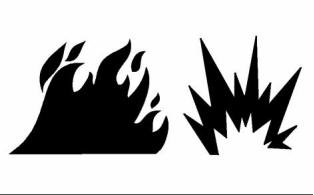
SEBU8352
9
Safety Section
Fire Prevention and Explosion Prevention
Exhaust shields (if equipped) protect hot exhaust
components from oil or fuel spray in case of a line,
a tube, or a seal failure. Exhaust shields must be
installed correctly.
Use caution when you are refueling an engine. Do
not smoke while you are refueling an engine. Do not
refuel an engine near open flames or sparks. Always
stop the engine before refueling.
Do not weld on lines or tanks that contain flammable
fluids. Do not flame cut lines or tanks that contain
flammable fluid. Clean any such lines or tanks
thoroughly with a nonflammable solvent prior to
welding or flame cutting.
Wiring must be kept in good condition. All electrical
wires must be correctly routed and securely attached.
Check all electrical wires daily. Repair any wires
that are loose or frayed before you operate the
engine. Clean all electrical connections and tighten
all electrical connections.
Eliminate all wiring that is unattached or unnecessary.
Do not use any wires or cables that are smaller than
the recommended gauge. Do not bypass any fuses
and/or circuit breakers.
Arcing or sparking could cause a fire. Secure
connections, recommended wiring, and correctly
maintained battery cables will help to prevent arcing
or sparking.
g00704135
Illustration 9
Gases from a battery can explode. Keep any open
flames or sparks away from the top of a battery. Do
not smoke in battery charging areas.
Inspect all lines and hoses for wear or for
deterioration. The hoses must be correctly routed.
The lines and hoses must have adequate support
and secure clamps. Tighten all connections to the
recommended torque. Leaks can cause fires.
Never check the battery charge by placing a metal
object across the terminal posts. Use a voltmeter or
a hydrometer.
Oil filters and fuel filters must be correctly installed.
The filter housings must be tightened to the correct
torque.
Incorrect jumper cable connections can cause
an explosion that can result in injury. Refer to
the Operation Section of this manual for specific
instructions.
Do not charge a frozen battery. This may cause an
explosion.
The batteries must be kept clean. The covers
(if equipped) must be kept on the cells. Use the
recommended cables, connections, and battery box
covers when the engine is operated.
Fire Extinguisher
Make sure that a fire extinguisher is available. Be
familiar with the operation of the fire extinguisher.
Inspect the fire extinguisher and service the fire
extinguisher regularly. Obey the recommendations
on the instruction plate.
g00704059
Illustration 8
This document has been printed from SPI². Not for Resale
![]()
![]()
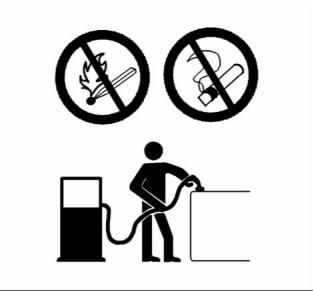
![]()
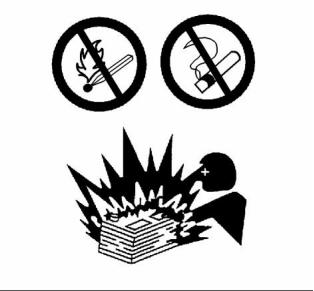
10
SEBU8352
Safety Section
Crushing Prevention and Cutting Prevention
Lines, Tubes and Hoses
When objects are struck, wear protective glasses in
order to avoid injury to the eyes.
Do not bend high pressure lines. Do not strike high
pressure lines. Do not install any lines that are bent
or damaged. Do not clip any other items to the high
pressure lines.
Chips or other debris may fly off objects when objects
are struck. Before objects are struck, ensure that no
one will be injured by flying debris.
Repair any lines that are loose or damaged. Leaks
can cause fires. Consult your Perkins dealer or your
Perkins distributor for repair or for replacement parts.
i01372247
Mounting and Dismounting
Check lines, tubes and hoses carefully. Do not use
your bare hand to check for leaks. Use a board or
cardboard to check for leaks. Tighten all connections
to the recommended torque.
Inspect the steps, the handholds, and the work area
before mounting the engine. Keep these items clean
and keep these items in good repair.
Replace the parts if any of the following conditions
are present:
Mount the engine and dismount the engine only at
locations that have steps and/or handholds. Do not
climb on the engine, and do not jump off the engine.
• End fittings are damaged or leaking.
• Outer coverings are chafed or cut.
• Wires are exposed.
Face the engine in order to mount the engine or
dismount the engine. Maintain a three-point contact
with the steps and handholds. Use two feet and one
hand or use one foot and two hands. Do not use any
controls as handholds.
• Outer coverings are ballooning.
• Flexible part of the hoses are kinked.
• Outer covers have embedded armoring.
• End fittings are displaced.
Do not stand on components which cannot support
your weight. Use an adequate ladder or use a work
platform. Secure the climbing equipment so that the
equipment will not move.
Do not carry tools or supplies when you mount the
engine or when you dismount the engine. Use a hand
line to raise and lower tools or supplies.
Make sure that all clamps, guards, and heat shields
are installed correctly. During engine operation, this
will help to prevent vibration, rubbing against other
parts, and excessive heat.
i02813489
Before Starting Engine
i02143194
Crushing Prevention and
Cutting Prevention
Before the initial start-up of an engine that is new,
serviced or repaired, make provision to shut the
engine off, in order to stop an overspeed. This may
be accomplished by shutting off the air and/or fuel
supply to the engine.
Support the component correctly when work beneath
the component is performed.
Overspeed shutdown should occur automatically for
engines that are controlled electronically. If automatic
shutdown does not occur, press the emergency stop
button in order to cut the fuel and/or air to the engine.
Unless other maintenance instructions are provided,
never attempt adjustments while the engine is
running.
Stay clear of all rotating parts and of all moving
parts. Leave the guards in place until maintenance
is performed. After the maintenance is performed,
reinstall the guards.
Inspect the engine for potential hazards.
Before starting the engine, ensure that no one is on,
underneath, or close to the engine. Ensure that the
area is free of personnel.
Keep objects away from moving fan blades. The fan
blades will throw objects or cut objects.
This document has been printed from SPI². Not for Resale
![]()
SEBU8352
11
Safety Section
Engine Starting
If equipped, ensure that the lighting system for the
engine is suitable for the conditions. Ensure that all
lights work correctly, if equipped.
Engine exhaust contains products of combustion
which can be harmful to your health. Always start the
engine and operate the engine in a well ventilated
area. If the engine is started in an enclosed area,
vent the engine exhaust to the outside.
All protective guards and all protective covers must
be installed if the engine must be started in order
to perform service procedures. To help prevent an
accident that is caused by parts in rotation, work
around the parts carefully.
Note: The engine is equipped with an automatic
device for cold starting for normal conditions of
operation. If the engine will be operated in very cold
conditions, then an extra cold starting aid may be
required. Normally, the engine will be equipped with
the correct type of starting aid for your region of
operation.
Do not bypass the automatic shutoff circuits. Do not
disable the automatic shutoff circuits. The circuits are
provided in order to help prevent personal injury. The
circuits are also provided in order to help prevent
engine damage.
The engines are equipped with a glow plug starting
aid in each individual cylinder that heats the intake
air in order to improve starting.
See the Service Manual for repairs and for
adjustments.
i01928905
i02207232
Engine Stopping
Engine Starting
Stop the engine according to the procedure in
the Operation and Maintenance Manual, “Engine
Stopping (Operation Section)” in order to avoid
overheating of the engine and accelerated wear of
the engine components.
Do not use aerosol types of starting aids such as
ether. Such use could result in an explosion and
personal injury.
Use the Emergency Stop Button (if equipped) ONLY
in an emergency situation. Do not use the Emergency
Stop Button for normal engine stopping. After an
emergency stop, DO NOT start the engine until the
problem that caused the emergency stop has been
corrected.
If a warning tag is attached to the engine start switch
or to the controls, DO NOT start the engine or move
the controls. Consult with the person that attached
the warning tag before the engine is started.
All protective guards and all protective covers must
be installed if the engine must be started in order
to perform service procedures. To help prevent an
accident that is caused by parts in rotation, work
around the parts carefully.
Stop the engine if an overspeed condition occurs
during the initial start-up of a new engine or an engine
that has been overhauled. This may be accomplished
by shutting off the fuel supply to the engine and/or
shutting off the air supply to the engine.
Start the engine from the operator’s compartment or
from the engine start switch.
i02176668
Electrical System
Always start the engine according to the procedure
that is described in the Operation and Maintenance
Manual, “Engine Starting” topic in the Operation
Section. Knowing the correct procedure will help to
prevent major damage to the engine components.
Knowing the procedure will also help to prevent
personal injury.
Never disconnect any charging unit circuit or battery
circuit cable from the battery when the charging unit
is operating. A spark can cause the combustible
gases that are produced by some batteries to ignite.
To ensure that the jacket water heater (if equipped)
and/or the lube oil heater (if equipped) is working
correctly, check the water temperature gauge and the
oil temperature gauge during the heater operation.
To help prevent sparks from igniting combustible
gases that are produced by some batteries, the
negative “−” jump start cable should be connected
last from the external power source to the negative
“−” terminal of the starting motor. If the starting motor
is not equipped with a negative “−” terminal, connect
the jump start cable to the engine block.
This document has been printed from SPI². Not for Resale
![]()
![]()
![]()
12
SEBU8352
Safety Section
Electrical System
Check the electrical wires daily for wires that are
loose or frayed. Tighten all loose electrical wires
before the engine is started. Repair all frayed
electrical wires before the engine is started. See
the Operation and Maintenance Manual for specific
starting instructions.
Grounding Practices
Correct grounding for the engine electrical system
is necessary for optimum engine performance
and reliability. Incorrect grounding will result in
uncontrolled electrical circuit paths and in unreliable
electrical circuit paths.
Uncontrolled electrical circuit paths can result in
damage to main bearings, to crankshaft bearing
journal surfaces, and to aluminum components.
Engines that are installed without engine-to-frame
ground straps can be damaged by electrical
discharge.
To ensure that the engine and the engine electrical
systems function correctly, an engine-to-frame
ground strap with a direct path to the battery must be
used. This path may be provided by way of a direct
engine ground to the frame.
All grounds should be tight and free of corrosion. The
engine alternator must be grounded to the negative
“-” battery terminal with a wire that is adequate to
handle the full charging current of the alternator.
This document has been printed from SPI². Not for Resale
![]()
SEBU8352
13
Product Information Section
Model Views
Product Information
Section
Model Views
i02869409
Model View Illustrations
1103D Engine Model Views
g01439632
Illustration 10
Typical example
(1) Front lifting eye
(4) Fuel filter
(8) Oil filter (horizontal installation)
(2) Water temperature regulator housing
(horizontal outlet)
(3) Fuel priming pump
(5) Breather tube
(6) Water pump
(7) Starting motor
(9) Crankshaft pulley
(10) Oil pan
This document has been printed from SPI². Not for Resale
![]()
![]()
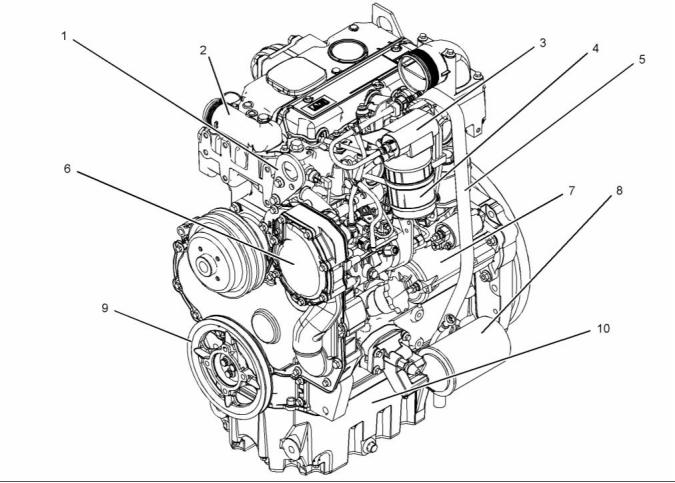
![]()
14
SEBU8352
Product Information Section
Model Views
g01434352
Illustration 11
Typical example
(11) Inlet manifold adapter
(12) Top cover
(13) Exhaust manifold
(14) Turbocharger (if equipped)
(15) Turbocharger oil supply (if equipped)
(16) Turbocharger oil return (if equipped)
(17) Rear lifting eye
(18) Flywheel housing
(19) Flywheel
Engine Specifications
i02813494
Engine Description
Note: The front end of the engine is opposite the
flywheel end of the engine. The left and the right
sides of the engine are determined from the flywheel
end. The number 1 cylinder is the front cylinder.
Perkins Engines are designed for the following
applications: machine and industrial mobile
equipment. The engines are available in the following
types of aspiration:
• Turbocharged aftercooled
• Turbocharged
• Naturally aspirated
This document has been printed from SPI². Not for Resale
![]()
![]()
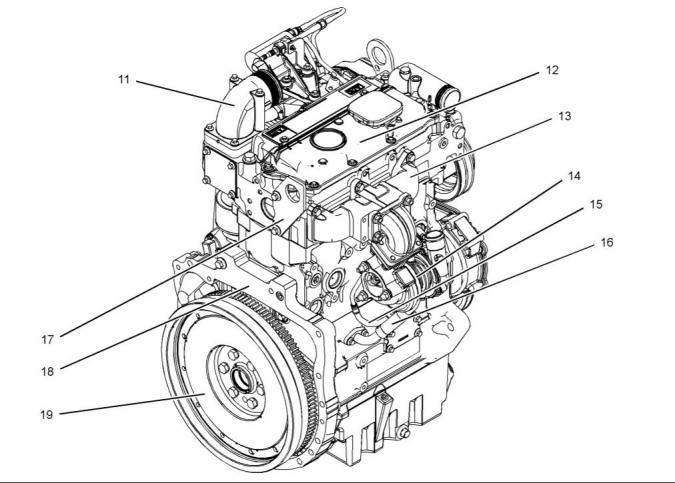
SEBU8352
15
Product Information Section
Model Views
The engine lubricating oil is supplied to the engine
by a gear-driven pump. The engine lubricating oil
is cooled and the engine lubricating oil is filtered.
Bypass valves provide unrestricted flow of lubrication
oil to the engine parts when oil viscosity is high.
Bypass valves can also provide unrestricted flow
of lubrication oil to the engine parts if the oil cooler
should become plugged or if the oil filter element
should become plugged.
Engine efficiency, efficiency of emission controls, and
engine performance depend on adherence to proper
operation and maintenance recommendations.
Engine performance and efficiency also depend on
the use of recommended fuels, lubrication oils, and
coolants. Refer to the Operation and Maintenance
Manual, “Maintenance Interval Schedule” for more
information on maintenance items.
g01222531
Illustration 12
A typical example of the layout of the valves
(A) Inlet valves
(B) Exhaust valves
Engine Service Life
Table 1
1103D Industrial Engine Specifications
Engine efficiency and maximum utilization of engine
performance depend on the adherence to proper
operation and maintenance recommendations. In
addition, use recommended fuels, coolants and
lubricants. Use the Operation and Maintenance
Manual as a guide for required engine maintenance.
Number of Cylinders
Bore
3 In-Line
105 mm (4.134 inch)
127 mm (5.0 inch)
Stroke
Aspiration
Turbocharged
Naturally aspirated
Expected engine life is generally predicted by the
average power that is demanded. The average power
that is demanded is based on fuel consumption of
the engine over a period of time. Reduced hours of
operation at full throttle and/or operating at reduced
throttle settings result in a lower average power
demand. Reduced hours of operation will increase
the length of operating time before an engine
overhaul is required.
Compression Ratio
NA 19.25:1
T 18.25:1
Displacement
3.3 L (201 in )
3
1 2 3
Firing Order
Rotation (flywheel end)
Valve Lash Setting (Inlet)
Counterclockwise
0.20 mm (0.008 inch)
0.45 mm (0.018 inch)
Valve Lash Setting
(Exhaust)
Engine Cooling and Lubrication
The cooling system consists of the following
components:
• Gear-driven centrifugal water pump
• Water temperature regulator which regulates the
engine coolant temperature
• Gear-driven oil pump (gear type)
• Oil cooler
This document has been printed from SPI². Not for Resale
![]()
![]()
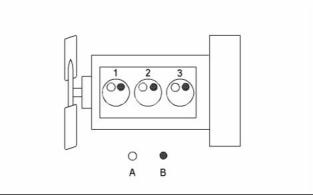
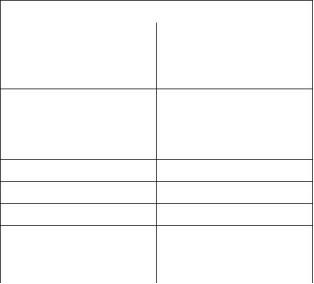
16
SEBU8352
Product Information Section
Product Identification Information
Product Identification
Information
i02813999
Engine Identification
Perkins engines are identified by a serial number.
This number is shown on a serial number plate that
is mounted on the left hand side of the engine block.
An example of an engine number is
XK12345U090001P.
XK __________________________________________Type of engine
XK12345____________________________Engine List Number
U ____________________________Built in the United Kingdom
090001 ___________________________Engine Serial Number
P _____________________________________Year of Manufacture
g01431025
Illustration 13
Location of serial number plate
Perkins distributors need these numbers in order to
determine the components that were included with
the engine. This permits accurate identification of
replacement part numbers.
i02875212
Serial Number Plate
g01431032
Illustration 14
The Serial Number Plate is located on the upper
left side of the engine block above the fuel injection
pump.
Typical serial number plate
(1) Temporary Parts List number
(2) List number
(3) Serial number
(4) Type
The following information is stamped on the Serial
Number Plate: Engine serial number, Model, and
Arrangement number.
This document has been printed from SPI². Not for Resale
![]()
![]()
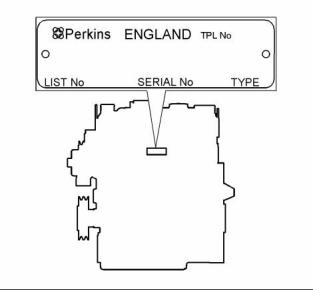
![]()
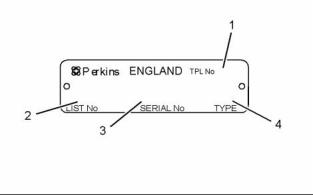
SEBU8352
17
Product Information Section
Product Identification Information
i02164876
Reference Numbers
S/N: XK11-Up
S/N: XL11-Up
Information for the following items may be needed to
order parts. Locate the information for your engine.
Record the information in the appropriate space.
Make a copy of this list for a record. Keep the
information for future reference.
Record for Reference
Engine Model _______________________________________________
Engine Serial number _____________________________________
Engine Low Idle rpm ______________________________________
Engine Full Load rpm _____________________________________
Primary Fuel Filter _________________________________________
Water Separator Element ________________________________
Secondary Fuel Filter Element __________________________
Lubrication Oil Filter Element ___________________________
Auxiliary Oil Filter Element _______________________________
Total Lubrication System Capacity _____________________
Total Cooling System Capacity _________________________
Air Cleaner Element _______________________________________
Fan Drive Belt ______________________________________________
Alternator Belt ______________________________________________
This document has been printed from SPI². Not for Resale
![]()
18
SEBU8352
Product Information Section
Product Identification I, nformation
i02869408
Emissions Certification Film
g01350379
Illustration 15
Typical example
This document has been printed from SPI². Not for Resale
![]()
![]()
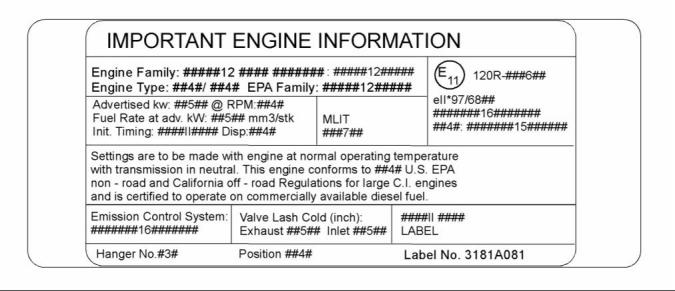
SEBU8352
19
Operation Section
Lifting and Storage
Operation Section
Lifting and Storage
i02677364
Product Storage
Table 2
i02677363
Required Tools
Part Description
Product Lifting
Part
Number
Tool
A
Qty
1
1772204
1762811
1734115
POWERPART Lay-Up 1
POWERPART Lay-Up 2
POWERPART Lay-Up 3
B
1
C
1
If the engine will not be started for several weeks, the
lubricating oil will drain from the cylinder walls and
from the piston rings. Rust can form on the cylinder
walls. Rust on the cylinder walls will cause increased
engine wear and a reduction in engine service life.
Lubrication System
To help prevent excessive engine wear, use the
following guidelines:
g00103219
Illustration 16
Complete all of the lubrication recommendations that
are listed in this Operation and Maintenance Manual,
“Maintenance Interval Schedule” (Maintenance
Section).
NOTICE
Never bend the eyebolts and the brackets. Only load
the eyebolts and the brackets under tension. Remem-
ber that the capacity of an eyebolt is less as the angle
between the supporting members and the object be-
comes less than 90 degrees.
If an engine is out of operation and if use of the engine
is not planned, special precautions should be made.
If the engine will be stored for more than one month,
a complete protection procedure is recommended.
When it is necessary to remove a component at an
angle, only use a link bracket that is properly rated for
the weight.
Use the following guidelines :
• Completely clean the outside of the engine.
Use a hoist to remove heavy components. Use
an adjustable lifting beam to lift the engine. All
supporting members (chains and cables) should be
parallel to each other. The chains and cables should
be perpendicular to the top of the object that is being
lifted.
• Drain the fuel system completely and refill the
system with preservative fuel. Tooling (A) can be
mixed with the normal fuel in order to change the
fuel into preservative fuel.
• If preservative fuel is not available, the fuel system
can be filled with normal fuel. This fuel must be
discarded at the end of the storage period together
with the fuel filter elements.
Some removals require lifting the fixtures in order to
obtain proper balance and safety.
To remove the engine ONLY, use the lifting eyes that
are on the engine.
• Operate the engine until the engine reaches normal
operating temperature. Stop any leaks from fuel,
lubricating oil or air systems. Stop the engine and
drain the lubricating oil from the oil pan.
Lifting eyes are designed and installed for specific
engine arrangements. Alterations to the lifting eyes
and/or the engine make the lifting eyes and the lifting
fixtures obsolete. If alterations are made, ensure
that proper lifting devices are provided. Consult your
Perkins dealer for information regarding fixtures for
proper engine lifting.
• Renew the canister(s) of the lubricating oil filter.
This document has been printed from SPI². Not for Resale
![]()
![]()
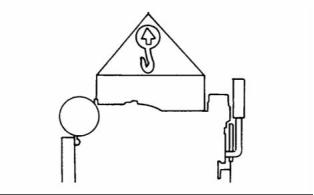
![]()
![]()
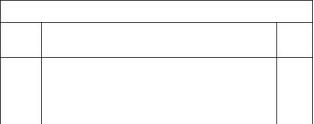
![]()
20
SEBU8352
Operation Section
Lifting and Storage
• Fill the oil pan to the Full Mark on the dipstick with
new, clean lubricating oil. Add Tooling (B) to the oil
in order to protect the engine against corrosion. If
Tooling (B) is not available, use a preservative of
the correct specification instead of the lubricating
oil. If a preservative is used, this must be drained
completely at the end of the storage period and
the oil pan must be refilled to the correct level with
normal lubricating oil.
3. Remove the drain plug (1) from the side of the
cylinder block in order to drain the engine. Ensure
that the drain hole is not restricted.
4. Open the tap or remove the drain plug at the
bottom of the radiator in order to drain the radiator.
If the radiator does not have a tap or a drain plug,
disconnect the hose at the bottom of the radiator.
5. Flush the cooling system with clean water.
Cooling System
6. Fit the drain plugs and the filler cap. Close the tap
or connect the radiator hose.
To help prevent excessive engine wear, use the
following guidelines:
7. Fill the cooling system with an approved antifreeze
mixture because this gives protection against
corrosion.
NOTICE
Do not drain the coolant while the engine is still hot and
the system is under pressure because dangerous hot
coolant can be discharged.
Note: Certain corrosion inhibitors could cause
damage to some engine components. Contact the
Service Department of Perkins for advice.
If freezing temperatures are expected, check the
cooling system for adequate protection against
freezing. See this Operation and Maintenance
Manual, “General Coolant Information” (Maintenance
Section).
8. Operate the engine for a short period in order to
circulate the lubricating oil and the coolant in the
engine.
9. Disconnect the battery. Put the battery into safe
storage in a fully charged condition. Before the
battery is put into storage, protect the terminals
against corrosion. Tooling (C) can be used on the
terminals.
NOTICE
To prevent frost damage, ensure that all the coolant is
removed from the engine. This is important if the sys-
tem is drained after it has been flushed with water, or if
an antifreeze solution too weak to protect the system
from frost has been used.
10. Clean the crankcase breather if one is installed.
Seal the end of the pipe.
11. Remove the fuel injector nozzles and spray
Tooling (B) for one or two seconds into each
cylinder bore with the piston at BDC.
12. Slowly rotate the crankshaft for one complete
revolution and then replace the fuel injector
nozzles.
Induction System
• Remove the air filter assembly. If necessary,
remove the pipes that are installed between the air
filter assembly and the turbocharger. Spray Tooling
(B) into the turbocharger. The duration of the spray
is printed on the container. Seal the turbocharger
with waterproof tape.
Exhaust System
• Remove the exhaust pipe. Spray Tooling (B) into
the turbocharger. The duration of the spray is
printed on the container. Seal the turbocharger
with waterproof tape.
g01356026
Illustration 17
1. Ensure that the vehicle is on level ground.
2. Remove the filler cap of the cooling system.
This document has been printed from SPI². Not for Resale
![]()
![]()
![]()
![]()
![]()
![]()
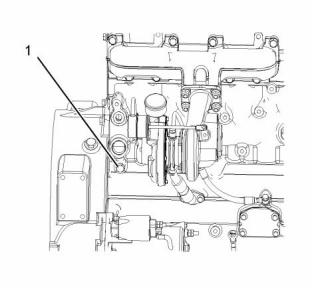
![]()
SEBU8352
21
Operation Section
Lifting and Storage
General Items
• If the lubricating oil filler is installed on the rocker
cover, remove the filler cap. If the lubricating
oil filler cap is not installed on the rocker cover,
remove the rocker cover. Spray Tooling (B) around
the rocker shaft assembly. Replace the filler cap
or the rocker cover.
• Seal the vent of the fuel tank or the fuel filler cap
with waterproof tape.
• Remove the alternator drive belts and put the drive
belts into storage.
• In order to prevent corrosion, spray the engine
with Tooling (C). Do not spray the area inside the
alternator.
When the engine protection has been completed in
accordance with these instructions, this ensures that
no corrosion will occur. Perkins are not responsible
for damage which may occur when an engine is in
storage after a period in service.
Your Perkins dealer or your Perkins distributor can
assist in preparing the engine for extended storage
periods.
This document has been printed from SPI². Not for Resale
![]()
22
SEBU8352
Operation Section
Gauges and Indicators
Gauges and Indicators
1. Reduce the load and the engine rpm.
2. Inspect the cooling system for leaks.
i02164190
3. Determine if the engine must be shut down
immediately or if the engine can be cooled by
reducing the load.
Gauges and Indicators
Tachometer – This gauge indicates engine
speed (rpm). When the throttle control lever
is moved to the full throttle position without
load, the engine is running at high idle. The engine is
running at the full load rpm when the throttle control
lever is at the full throttle position with maximum
rated load.
Your engine may not have the same gauges or all of
the gauges that are described. For more information
about the gauge package, see the OEM information.
Gauges provide indications of engine performance.
Ensure that the gauges are in good working order.
Determine the normal operating range by observing
the gauges over a period of time.
NOTICE
To help prevent engine damage, never exceed the
high idle rpm. Overspeeding can result in serious
damage to the engine. The engine can be operated
at high idle without damage, but should never be
allowed to exceed high idle rpm.
Noticeable changes in gauge readings indicate
potential gauge or engine problems. Problems may
also be indicated by gauge readings that change
even if the readings are within specifications.
Determine and correct the cause of any significant
change in the readings. Consult your Perkins dealer
or your Perkins distributor for assistance.
Ammeter – This gauge indicates the
amount of charge or discharge in the
NOTICE
battery charging circuit. Operation of the
indicator should be to the right side of “0” (zero).
If no oil pressure is indicated, STOP the engine. If
maximum coolant temperature is exceeded, STOP
the engine. Engine damage can result.
Fuel Level – This gauge indicates the fuel
level in the fuel tank. The fuel level gauge
operates when the “START/STOP” switch
is in the “ON” position.
Engine Oil Pressure – The oil pressure
should be greatest after a cold engine is
started. The typical engine oil pressure with
SAE10W30 is 207 to 413 kPa (30 to 60 psi) at rated
rpm.
Service Hour Meter – The gauge indicates
operating time of the engine.
A lower oil pressure is normal at low idle. If the load
is stable and the gauge reading changes, perform
the following procedure:
1. Remove the load.
2. Reduce engine speed to low idle.
3. Check and maintain the oil level.
Jacket Water Coolant Temperature –
Typical temperature range is 71 to 96°C
(160 to 205°F). The maximum allowable
temperature with the pressurized cooling system at
48 kPa (7 psi) is 110°C (230°F). Higher temperatures
may occur under certain conditions. The water
temperature reading may vary according to load. The
reading should never exceed the boiling point for the
pressurized system that is being used.
If the engine is operating above the normal range
and steam becomes apparent, perform the following
procedure:
This document has been printed from SPI². Not for Resale
![]()
![]()
![]()
![]()
![]()
![]()
![]()
![]()
![]()
![]()
![]()
SEBU8352
23
Operation Section
Features and Controls
Features and Controls
i02690464
Fuel Shutoff
The fuel shutoff solenoid is located on the fuel
injection pump.
When the fuel shutoff solenoid is activated, the
solenoid moves to the “Open” position.
When the fuel shutoff solenoid is deactivated, the
solenoid moves to the “Closed” position.
This document has been printed from SPI². Not for Resale
![]()
24
SEBU8352
Operation Section
Engine Starting
Engine Starting
• Do not start the engine or move any of the controls
if there is a “DO NOT OPERATE” warning tag or
similar warning tag attached to the start switch or
to the controls.
i02675151
Before Starting Engine
• Ensure that the areas around the rotating parts are
clear.
• All of the guards must be put in place. Check for
damaged guards or for missing guards. Repair
any damaged guards. Replace damaged guards
and/or missing guards.
Before the engine is started, perform the required
daily maintenance and any other periodic
maintenance that is due. Refer to the Operation
and Maintenance Manual, “Maintenance Interval
Schedule” for more information.
• Disconnect any battery chargers that are not
protected against the high current drain that
is created when the electric starting motor is
engaged. Check electrical cables and check the
battery for poor connections and for corrosion.
• For the maximum service life of the engine, make a
thorough inspection within the engine compartment
before the engine is started. Look for the following
items: oil leaks, coolant leaks, loose bolts, and
excessive dirt and/or grease. Remove any excess
dirt and/or grease buildup. Repair any faults that
were identified during the inspection.
• Reset all of the shutoffs or alarm components (if
equipped).
• Check the engine lubrication oil level. Maintain the
oil level between the “MIN” mark and the “MAX”
mark on the engine oil level gauge.
• Inspect the cooling system hoses for cracks and
for loose clamps.
• Inspect the alternator and accessory drive belts for
cracks, breaks, and other damage.
• Check the coolant level. Observe the coolant level
in the header tank (if equipped). Maintain the
coolant level to the “FULL” mark on the header
tank.
• Inspect the wiring for loose connections and for
worn wires or frayed wires.
• If the engine is not equipped with a header tank
maintain the coolant level within 13 mm (0.5 inch)
of the bottom of the filler pipe. If the engine is
equipped with a sight glass, maintain the coolant
level in the sight glass.
• Check the fuel supply. Drain water from the water
separator (if equipped). Open the fuel supply valve
(if equipped).
NOTICE
• Observe the air cleaner service indicator (if
equipped). Service the air cleaner when the yellow
diaphragm enters the red zone, or when the red
piston locks in the visible position.
All valves in the fuel return line must be open before
and during engine operation to help prevent high fuel
pressure. High fuel pressure may cause filter housing
failure or other damage.
• Ensure that any equipment that is driven by the
engine has been disengaged from the engine.
Minimize electrical loads or remove any electrical
loads.
If the engine has not been started for several weeks,
fuel may have drained from the fuel system. Air
may have entered the filter housing. Also, when fuel
filters have been changed, some air pockets will be
trapped in the engine. In these instances, prime the
fuel system. Refer to the Operation and Maintenance
Manual, “Fuel System - Prime” for more information
on priming the fuel system.
Engine exhaust contains products of combustion
which may be harmful to your health. Always start
and operate the engine in a well ventilated area
and, if in an enclosed area, vent the exhaust to the
outside.
This document has been printed from SPI². Not for Resale
![]()
![]()
![]()
![]()
![]()
SEBU8352
25
Operation Section
Engine Starting
i02198348
When Group 2 diesel fuel is used, the following items
provide a means of minimizing starting problems
and fuel problems in cold weather: engine oil pan
heaters, jacket water heaters, fuel heaters, and fuel
line insulation.
Starting the Engine
Use the procedure that follows for cold weather
starting.
Do not use aerosol types of starting aids such as
ether. Such use could result in an explosion and
personal injury.
1. If equipped, move the throttle lever to the full
throttle position before you start the engine.
2. If equipped, turn the engine start switch to the
HEAT position. Hold the engine start switch in the
HEAT position for 6 seconds until the glow plug
indicator light illuminates. This will activate the
glow plugs and aid in the starting of the engine.
Refer to the OMM for your type of controls. Use the
following procedure to start the engine.
1. If equipped, move the throttle lever to the full
throttle position before you start the engine.
NOTICE
NOTICE
Do not crank the engine for more than 30 seconds.
Allow the electric starting motor to cool for two minutes
before cranking the engine again.
Do not crank the engine for more than 30 seconds.
Allow the electric starting motor to cool for two minutes
before cranking the engine again.
3. While the glow plug indicator light is illuminated,
turn the engine start switch to the START position
and crank the engine.
2. Turn the engine start switch to the START position.
Hold the engine start switch in the START position
and crank the engine.
Note: If the glow plug indicator light illuminates
rapidly for 2 to 3 seconds, or if the glow plug indicator
light fails to illuminate, a malfunction exists in the cold
start system. Do not use ether or other starting fluids
to start the engine.
3. When the engine starts, release the engine start
switch.
4. If equipped, slowly move the throttle lever to the
low idle position and allow the engine to idle. Refer
to the Operation and Maintenance Manual, “After
Starting Engine” topic.
4. When the engine starts, release the engine start
switch key.
5. If the engine does not start, release the engine
start switch and allow the electric starting motor to
cool. Then, repeat steps 2 through step 4.
5. If the engine does not start, release the engine
start switch and allow the starter motor to cool.
Then, repeat steps 2 through step 4.
6. Turn the engine start switch to the OFF position in
order to stop the engine.
6. If the engine is equipped with a throttle allow the
engine to idle for three to five minutes, or allow the
engine to idle until the water temperature indicator
begins to rise. The engine should run at low idle
smoothly until speed is gradually increased to high
idle. Allow the white smoke to disperse before
proceeding with normal operation.
i02198092
Cold Weather Starting
7. Operate the engine at low load until all systems
reach operating temperature. Check the gauges
during the warm-up period.
Do not use aerosol types of starting aids such as
ether. Such use could result in an explosion and
personal injury.
8. Turn the engine start switch to the OFF position in
order to stop the engine.
Startability will be improved at temperatures below
−18 °C (0 °F) from the use of a jacket water heater
or extra battery capacity.
This document has been printed from SPI². Not for Resale
![]()
![]()
![]()
![]()
![]()
![]()
![]()
![]()
![]()
26
SEBU8352
Operation Section
Engine Starting
i02177935
3. Connect one negative end of the jump start cable
to the negative cable terminal of the electrical
source. Connect the other negative end of the
jump start cable to the engine block or to the
chassis ground. This procedure helps to prevent
potential sparks from igniting the combustible
gases that are produced by some batteries.
Starting with Jump Start
Cables
4. Start the engine.
Improper jump start cable connections can cause
an explosion resulting in personal injury.
5. Immediately after the stalled engine is started,
disconnect the jump start cables in reverse order.
Prevent sparks near the batteries. Sparks could
cause vapors to explode. Do not allow jump start
cable ends to contact each other or the engine.
After jump starting, the alternator may not be able to
fully recharge batteries that are severely discharged.
The batteries must be replaced or charged to the
correct voltage with a battery charger after the engine
is stopped. Many batteries which are considered
unusable are still rechargeable. Refer to Operation
and Maintenance Manual, “Battery - Replace” and
Testing and Adjusting Manual, “Battery - Test”.
Note: If it is possible, first diagnose the reason
for the starting failure. Make any necessary
repairs. If the engine will not start only due to
the condition of the battery, either charge the
battery, or start the engine with jump start cables.
The condition of the battery can be rechecked
after the engine has been switched OFF.
i01903609
After Starting Engine
NOTICE
Using a battery source with the same voltage as the
electric starting motor. Use ONLY equal voltage for
jump starting. The use of higher voltage will damage
the electrical system.
Note: In temperatures from 0 to 60°C (32 to 140°F),
the warm-up time is approximately three minutes. In
temperatures below 0°C (32°F), additional warm-up
time may be required.
Do not reverse the battery cables. The alternator can
be damaged. Attach ground cable last and remove
first.
When the engine idles during warm-up, observe the
following conditions:
• Check for any fluid or for any air leaks at idle rpm
and at one-half full rpm (no load on the engine)
before operating the engine under load. This is not
possible in some applications.
When using an external electrical source to start the
engine, turn the generator set control switch to the
“OFF” position. Turn all electrical accessories OFF be-
fore attaching the jump start cables.
• Operate the engine at low idle until all systems
achieve operating temperatures. Check all gauges
during the warm-up period.
Ensure that the main power switch is in the OFF posi-
tion before attaching the jump start cables to the en-
gine being started.
Note: Gauge readings should be observed and
the data should be recorded frequently while the
engine is operating. Comparing the data over time
will help to determine normal readings for each
gauge. Comparing data over time will also help
detect abnormal operating developments. Significant
changes in the readings should be investigated.
1. Turn the start switch to the OFF position. Turn off
all the engine’s accessories.
2. Connect one positive end of the jump start cable
to the positive cable terminal of the discharged
battery. Connect the other positive end of the jump
start cable to the positive cable terminal of the
electrical source.
This document has been printed from SPI². Not for Resale
![]()
![]()
![]()
![]()
![]()
SEBU8352
27
Operation Section
Engine Operation
Engine Operation
i02330149
Fuel Conservation Practices
i02176671
Engine Operation
The efficiency of the engine can affect the fuel
economy. Perkins design and technology in
manufacturing provides maximum fuel efficiency in
all applications. Follow the recommended procedures
in order to attain optimum performance for the life
of the engine.
Correct operation and maintenance are key factors
in obtaining the maximum life and economy of
the engine. If the directions in the Operation and
Maintenance Manual are followed, costs can be
minimized and engine service life can be maximized.
• Avoid spilling fuel.
The engine can be operated at the rated rpm after the
engine reaches operating temperature. The engine
will reach normal operating temperature sooner
during a low engine speed (rpm) and during a low
power demand. This procedure is more effective than
idling the engine at no load. The engine should reach
operating temperature in a few minutes.
Fuel expands when the fuel is warmed up. The fuel
may overflow from the fuel tank. Inspect fuel lines for
leaks. Repair the fuel lines, as needed.
• Be aware of the properties of the different fuels.
Use only the recommended fuels.
• Avoid unnecessary idling.
Gauge readings should be observed and the data
should be recorded frequently while the engine
is operating. Comparing the data over time will
help to determine normal readings for each gauge.
Comparing data over time will also help detect
abnormal operating developments. Significant
changes in the readings should be investigated.
Shut off the engine rather than idle for long periods of
time.
• Observe the air cleaner service indicator frequently.
Keep the air cleaner elements clean.
• Maintain the electrical systems.
i01929404
One damaged battery cell will overwork the alternator.
This will consume excess power and excess fuel.
Engine Warm-up
• Ensure that the drive belts are correctly adjusted.
The drive belts should be in good condition.
1. Run the engine at low idle for three to five minutes,
or run the engine at low idle until the jacket water
temperature starts to rise.
• Ensure that all of the connections of the hoses are
tight. The connections should not leak.
• Ensure that the driven equipment is in good
working order.
More time may be necessary when the
temperature is below −18°C (0°F).
• Cold engines consume excess fuel. Utilize heat
from the jacket water system and the exhaust
system, when possible. Keep cooling system
components clean and keep cooling system
components in good repair. Never operate the
engine without water temperature regulators.
All of these items will help maintain operating
temperatures.
2. Check all of the gauges during the warm-up
period.
3. Perform a walk-around inspection. Check the
engine for fluid leaks and air leaks.
4. Increase the rpm to the rated rpm. Check for
fluid leaks and air leaks. The engine may be
operated at full rated rpm and at full load when
the temperature of the water jacket reaches 60°C
(140°F).
This document has been printed from SPI². Not for Resale
![]()
28
SEBU8352
Operation Section
Engine Stopping
Engine Stopping
Stopping the Engine
NOTICE
i02818879
After Stopping Engine
i01929389
Note: Before you check the engine oil, do not operate
the engine for at least 10 minutes in order to allow
the engine oil to return to the oil pan.
• Check the crankcase oil level. Maintain the oil level
between the “ADD” mark and the “FULL” mark on
the oil level dipstick.
Stopping the engine immediately after it has been
working under load can result in overheating and ac-
celerated wear of the engine components.
• If necessary, perform minor adjustments. Repair
any leaks and tighten any loose bolts.
If the engine has been operating at high rpm and/or
high loads, run at low idle for at least three minutes
to reduce and stabilize internal engine temperature
before stopping the engine.
• Note the required service interval. Perform
the maintenance that is in the Operation and
Maintenance Manual, “Maintenance Interval
Schedule”.
Avoiding hot engine shutdowns will maximize tur-
bocharger shaft and bearing life.
• Fill the fuel tank in order to help prevent
accumulation of moisture in the fuel. Do not overfill
the fuel tank.
Prior to stopping an engine that is being operated
at low loads, operate the engine at low idle for 30
seconds before stopping. If the engine has been
operating at highway speeds and/or at high loads,
operate the engine at low idle for at least three
minutes. This procedure will cause the internal
engine temperature to be reduced and stabilized.
NOTICE
Only use antifreeze/coolant mixtures recommended in
the Refill Capacities and Recommendations topic that
is in this Operation and Maintenance Manual. Failure
to do so can cause engine damage.
Ensure that the engine stopping procedure is
understood. Stop the engine according to the shutoff
system on the engine or refer to the instructions that
are provided by the OEM.
Pressurized System: Hot coolant can cause seri-
ous burns. To open the cooling system filler cap,
stop the engine and wait until the cooling system
components are cool. Loosen the cooling system
pressure cap slowly in order to relieve the pres-
sure.
• To stop the engine, turn the ignition key switch to
the OFF position.
i01903586
Emergency Stopping
• Allow the engine to cool. Check the coolant level.
• If freezing temperatures are expected, check the
coolant for the correct antifreeze protection. The
cooling system must be protected against freezing
to the lowest expected outside temperature. Add
the correct coolant/water mixture, if necessary.
NOTICE
Emergency shutoff controls are for EMERGENCY use
ONLY. DO NOT use emergency shutoff devices or
controls for normal stopping procedure.
• Perform all required periodic maintenance on all
driven equipment. This maintenance is outlined in
the instructions from the OEM.
The OEM may have equipped the application with
an emergency stop button. For more information
about the emergency stop button, refer to the OEM
information.
Ensure that any components for the external system
that support the engine operation are secured after
the engine is stopped.
This document has been printed from SPI². Not for Resale
![]()
![]()
![]()
![]()
![]()
![]()
![]()
![]()
![]()
SEBU8352
29
Operation Section
Cold Weather Operation
Cold Weather Operation
• Install the correct specification of engine lubricant
before the beginning of cold weather.
• Check all rubber parts (hoses, fan drive belts, etc)
weekly.
i02717265
Cold Weather Operation
• Check all electrical wiring and connections for any
fraying or damaged insulation.
Perkins Diesel Engines can operate effectively in
cold weather. During cold weather, the starting and
the operation of the diesel engine is dependent on
the following items:
• Keep all batteries fully charged and warm.
• Fill the fuel tank at the end of each shift.
• Check the air cleaners and the air intake daily.
Check the air intake more often when you operate
in snow.
• The type of fuel that is used
• The viscosity of the engine oil
• The operation of the glow plugs
• Optional Cold starting aid
• Ensure that the glow plugs are in working order.
Refer to Testing and Adjusting Manual, “Glow Plug
- Test”.
• Battery condition
Personal injury or property damage can result
from alcohol or starting fluids.
This section will cover the following information:
• Potential problems that are caused by cold weather
operation
Alcohol or starting fluids are highly flammable and
toxic and if improperly stored could result in injury
or property damage.
• Suggest steps which can be taken in order to
minimize starting problems and operating problems
when the ambient air temperature is between
0° to−40 °C (32° to 40 °F).
Do not use aerosol types of starting aids such as
ether. Such use could result in an explosion and
personal injury.
The operation and maintenance of an engine in
freezing temperatures is complex . This is because
of the following conditions:
• Weather conditions
• Engine applications
• For jump starting with cables in cold weather,
refer to the Operation and Maintenance Manual,
“Starting with Jump Start Cables.” for instructions.
Recommendations from your Perkins dealer or
your Perkins distributor are based on past proven
practices. The information that is contained in
this section provides guidelines for cold weather
operation.
Viscosity of the Engine Lubrication
Oil
Correct engine oil viscosity is essential. Oil viscosity
affects the amount of torque that is needed to
crank the engine. Refer to this Operation and
Maintenance Manual, “Fluid Recommendations” for
the recommended viscosity of oil.
Hints for Cold Weather Operation
• If the engine will start, operate the engine until a
minimum operating temperature of 81 °C (177.8 °F)
is achieved. Achieving operating temperature will
help prevent the intake valves and exhaust valves
from sticking.
Recommendations for the Coolant
Provide cooling system protection for the lowest
expected outside temperature. Refer to this Operation
and Maintenance Manual, “Fluid Recommendations”
for the recommended coolant mixture.
• The cooling system and the lubrication system
for the engine do not lose heat immediately upon
shutdown. This means that an engine can be shut
down for a period of time and the engine can still
have the ability to start readily.
This document has been printed from SPI². Not for Resale
![]()
![]()
![]()
![]()
![]()
30
SEBU8352
Operation Section
Cold Weather Operation
In cold weather, check the coolant often for the
correct glycol concentration in order to ensure
adequate freeze protection.
• Free operation of the valves is prevented.
• Valves become stuck.
• Pushrods may become bent.
Engine Block Heaters
• Other damage to valve train components can
result.
Engine block heaters (if equipped) heat the
engine jacket water that surrounds the combustion
chambers. This provides the following functions:
For this reason, when the engine is started,
the engine must be operated until the coolant
temperature is 71 °C (160 °F) minimum. Carbon
deposits on the valve stems will be kept at a minimum
and the free operation of the valves and the valve
components will be maintained.
• Startability is improved.
• Warm up time is reduced.
An electric block heater can be activated once
the engine is stopped. An effective block heater
is typically a 1250/1500 W unit. Consult your
Perkins dealer or your Perkins distributor for more
information.
In addition, the engine must be thoroughly warmed in
order to keep other engine parts in better condition
and the service life of the engine will be generally
extended. Lubrication will be improved. There will be
less acid and less sludge in the oil. This will provide
longer service life for the engine bearings, the piston
rings, and other parts. However, limit unnecessary
idle time to ten minutes in order to reduce wear and
unnecessary fuel consumption.
Idling the Engine
When idling after the engine is started in cold
weather, increase the engine rpm from 1000 to 1200
rpm. This will warm up the engine more quickly.
Maintaining an elevated low idle speed for extended
periods will be easier with the installation of a hand
throttle. The engine should not be “raced” in order to
speed up the warm up process.
The Water Temperature Regulator and
Insulated Heater Lines
The engine is equipped with a water temperature
regulator. When the engine coolant is below the
correct operating temperature jacket water circulates
through the engine cylinder block and into the
engine cylinder head. The coolant then returns to the
cylinder block via an internal passage that bypasses
the valve of the coolant temperature regulator. This
ensures that coolant flows around the engine under
cold operating conditions. The water temperature
regulator begins to open when the engine jacket
water has reached the correct minimum operating
temperature. As the jacket water coolant temperature
rises above the minimum operating temperature the
water temperature regulator opens further allowing
more coolant through the radiator to dissipate excess
heat.
While the engine is idling, the application of a light
load (parasitic load) will assist in achieving the
minimum operating temperature. The minimum
operating temperature is 82 °C (179.6 °F).
Recommendations for Coolant
Warm Up
Warm up an engine that has cooled below normal
operating temperatures due to inactivity. This should
be performed before the engine is returned to full
operation. During operation in very cold temperature
conditions, damage to engine valve mechanisms can
result from engine operation for short intervals. This
can happen if the engine is started and the engine is
stopped many times without being operated in order
to warm up completely.
The progressive opening of the water temperature
regulator operates the progressive closing of the
bypass passage between the cylinder block and
head. This ensures maximum coolant flow to
the radiator in order to achieve maximum heat
dissipation.
When the engine is operated below normal operating
temperatures, fuel and oil are not completely burned
in the combustion chamber. This fuel and oil causes
soft carbon deposits to form on the valve stems.
Generally, the deposits do not cause problems and
the deposits are burned off during operation at
normal engine operating temperatures.
Note: Perkins discourages the use of all air flow
restriction devices such as radiator shutters.
Restriction of the air flow can result in the following:
high exhaust temperatures, power loss, excessive
fan usage, and reduction in fuel economy.
When the engine is started and the engine is stopped
many times without being operated in order to warm
up completely, the carbon deposits become thicker.
This can cause the following problems:
This document has been printed from SPI². Not for Resale
![]()
SEBU8352
31
Operation Section
Cold Weather Operation
A cab heater is beneficial in very cold weather. The
feed from the engine and the return lines from the
cab should be insulated in order to reduce heat loss
to the outside air.
When Group 2 diesel fuels are used the following
components provide a means of minimizing problems
in cold weather:
• Glow plugs (if equipped)
Insulating the Air Inlet and Engine
Compartment
• Engine coolant heaters, which may be an OEM
option
When temperatures below −18 °C (−0 °F) will be
frequently encountered, an air cleaner inlet that
is located in the engine compartment may be
specified. An air cleaner th, at is located in the engine
compartment may also minimize the entry of snow
into the air cleaner. Also, heat that is rejected by the
engine helps to warm the intake air.
• Fuel heaters, which may be an OEM option
• Fuel line insulation, which may be an OEM option
There are three major differences between Group
1 fuels and Group 2 fuels. Group 1 fuels have the
following different characteristics to Group 2 fuels.
Additional heat can be retained around the engine by
insulating the engine compartment.
• A lower cloud point
• A lower pour point
i02322217
Fuel and the Effect from Cold
Weather
• A higher energy per unit volume of fuel
Note: Group 3 fuels reduce the life of the engine. The
use of Group 3 fuels is not covered by the Perkins
warranty.
Group 3 fuels include Low Temperature Fuels and
Aviation Kerosene Fuels.
Note: Only use grades of fuel that are recommended
by Perkins. Refer to this Operation and Maintenance
Manual, “Fluid Recommendations”.
Special fuels include Biofuel.
The following fuels can be used in this series of
engine.
The cloud point is a temperature that allows wax
crystals to form in the fuel. These crystals can cause
the fuel filters to plug.
• Group 1
The pour point is the temperature when diesel fuel
will thicken. The diesel fuel becomes more resistant
to flow through fuel lines, fuel filters,and fuel pumps.
• Group 2
• Group 3
Be aware of these facts when diesel fuel is
purchased. Consider the average ambient air
temperature for the engine’s application. Engines
that are fueled in one climate may not operate well if
the engines are moved to another climate. Problems
can result due to changes in temperature.
• Special Fuels
Perkins prefer only Group 1 and Group 2 fuels for
use in this series of engines.
Group 1 fuels are the preferred Group of Fuels for
general use by Perkins. Group 1 fuels maximize
engine life and engine performance. Group 1 fuels
are usually less available than Group 2 fuels.
Frequently, Group 1 fuels are not available in colder
climates during the winter.
Before troubleshooting for low power or for poor
performance in the winter, check the fuel for waxing.
Low temperature fuels may be available for engine
operation at temperatures below 0 °C (32 °F). These
fuels limit the formation of wax in the fuel at low
temperatures.
Note: Group 2 fuels must have a maximum wear
scar of 650 micrometers (HFRR to ISO 12156-1).
For more information on cold weather operation, refer
to the Operation and Maintenance Manual, “Cold
Weather Operation and Fuel Related Components in
Cold Weather”.
Group 2 fuels are considered acceptable for issues
of warranty. This group of fuels may reduce the life
of the engine, the engine’s maximum power, and the
engine’s fuel efficiency.
This document has been printed from SPI². Not for Resale
![]()
32
SEBU8352
Operation Section
Cold Weather Operation
i01903588
Fuel Related Components in
Cold Weather
Fuel Tanks
Condensation can form in partially filled fuel tanks.
Top off the fuel tanks after you operate the engine.
Fuel tanks should contain some provision for draining
water and sediment from the bottom of the tanks.
Some fuel tanks use supply pipes that allow water
and sediment to settle below the end of the fuel
supply pipe.
Some fuel tanks use supply lines that take fuel
directly from the bottom of the tank. If the engine is
equipped with this system, regular maintenance of
the fuel system filter is important.
Drain the water and sediment from any fuel storage
tank at the following intervals: weekly, oil changes,
and refueling of the fuel tank. This will help prevent
water and/or sediment from being pumped from the
fuel storage tank and into the engine fuel tank.
Fuel Filters
It is possible that a primary fuel filter is installed
between the fuel tank and the engine fuel inlet. After
you change the fuel filter, always prime the fuel
system in order to remove air bubbles from the fuel
system. Refer to the Operation and Maintenance
Manual in the Maintenance Section for more
information on priming the fuel system.
The micron rating and the location of a primary fuel
filter is important in cold weather operation. The
primary fuel filter and the fuel supply line are the most
common components that are affected by cold fuel.
Fuel Heaters
Note: The OEM may equip the application with fuel
heaters. If this is the case, disconnect an electric type
of fuel heater in warm weather in order to prevent
overheating of the fuel. If the type of fuel heater is a
heat exchanger, the OEM should have included a
bypass for warm weather. Ensure that the bypass is
operational during warm weather in order to prevent
overheating of the fuel.
For more information about fuel heaters (if equipped),
refer to the OEM information.
This document has been printed from SPI². Not for Resale
![]()
SEBU8352
33
Maintenance Section
Refill Capacities
Maintenance Section
1103D Engine
Table 4
1103D Naturally Aspirated Engine without
an oil cooler
Refill Capacities
Compartment or System
Engine Only
External cooling system capacity
Liters
Quarts
i02814021
4.21
4
Refill Capacities
(OEM recommendation)
(1)
Total Cooling System
(2)
(1) The external cooling system includes a radiator or an
Lubrication System
expansion tank with the following components: heat exchanger,
aftercooler, and piping. Refer to the OEM specifications. Enter
the value for the external system capacity in this row.
(2) The Total Cooling System includes the capacity for the engine
cooling system plus the capacity for the external cooling
system. Enter the total in this row.
The refill capacities for the engine crankcase
reflect the approximate capacity of the crankcase
or sump plus standard oil filters. Auxiliary oil filter
systems will require additional oil. Refer to the OEM
specifications for the capacity of the auxiliary oil filter.
Refer to the Operation and Maintenance Manual,
“Maintenance Section” for more information on
Lubricant Specifications.
Table 5
1103D Naturally Aspirated Engines and
Turbocharged Engines with an oil cooler
Compartment or System
Engine Only
External cooling system capacity
Liters
Quarts
1103D Engine
4.43
4.02
Table 3
(OEM recommendation)
(1)
1103D Engine
Total Cooling System
(2)
Compartment or System
Liters
Quarts
(1) The external cooling system includes a radiator or an
Standard Oil Sump for the Engine
expansion tank with the following components: heat exchanger,
aftercooler, and piping. Refer to the OEM specifications. Enter
the value for the external system capacity in this row.
(2) The Total Cooling System includes the capacity for the engine
cooling system plus the capacity for the external cooling
system. Enter the total in this row.
6.5
7
Crankcase
(1)
(1) These values are the approximate capacities for the crankcase
oil sump which include the standard factory installed oil filters.
Engines with auxiliary oil filters will require additional oil. Refer
to the OEM specifications for the capacity of the auxiliary oil
filter.
i02883944
Cooling System
Fluid Recommendations
To maintain the cooling system, the Total Cooling
System capacity must be known. The approximate
capacity for the engine cooling system is listed
below. External System capacities will vary among
applications. Refer to the OEM specifications for the
External System capacity. This capacity information
will be needed in order to determine the amount
of coolant/antifreeze that is required for the Total
Cooling System.
Cooling System Specifications
General Coolant Information
NOTICE
Never add coolant to an overheated engine. Engine
damage could result. Allow the engine to cool first.
NOTICE
If the engine is to be stored in, or shipped to an area
with below freezing temperatures, the cooling system
must be either protected to the lowest outside temper-
ature or drained completely to prevent damage.
This document has been printed from SPI². Not for Resale
![]()

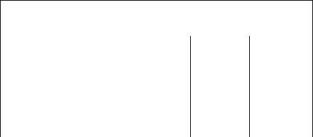
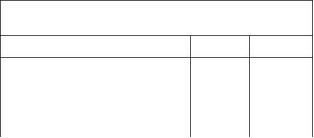
![]()
![]()
![]()
![]()
![]()
34
SEBU8352
Maintenance Section
Refill Capacities
Table 6
NOTICE
Frequently check the specific gravity of the coolant for
proper freeze protection or for anti-boil protection.
Acceptable Water
Maximum Limit
Property
Chloride (Cl)
Sulfate (SO4)
Total Hardness
Total Solids
Acidity
40 mg/L
100 mg/L
Clean the cooling system for the following reasons:
• Contamination of the cooling system
• Overheating of the engine
170 mg/L
340 mg/L
pH of 5.5 to 9.0
• Foaming of the coolant
For a water analysis, consult one of the following
sources:
NOTICE
Never operate an engine without water temperature
regulators in the cooling system. Water temperature
regulators help to maintain the engine coolant at the
proper operating temperature. Cooling system prob-
lems can develop without water temperature regula-
tors.
• Local water utility company
• Agricultural agent
• Independent laboratory
Additives
Many engine failures are related to the cooling
system. The following problems are related to cooling
system failures: Overheating, leakage of the water
pump, and plugged radiators or heat exchangers.
Additives help to protect the metal surfaces of
the cooling system. A lack of coolant additives or
insufficient amounts of additives enable the following
conditions to occur:
These failures can be avoided with correct cooling
system maintenance. Cooling system maintenance is
as important as maintenance of the fuel system and
the lubrication system. Quality of the coolant is as
important as the quality of the fuel and the lubricating
oil.
• Corrosion
• Formation of mineral deposits
• Rust
Coolant is normally composed of three elements:
Water, additives, and glycol.
• Scale
• Foaming of the coolant
Water
Many additives are depleted during engine operation.
These additives must be replaced periodically.
Water is used in the cooling system in order to
transfer heat.
Additives must be added at the correct concentration.
Overconcentration of additives can cause the
inhibitors to drop out-of-solution. The deposits can
enable the following problems to occur:
Distilled water or deionized water is
recommended for use in engine cooling systems.
DO NOT use the following types of water in cooling
systems: Hard water, softened water that has been
conditioned with salt, and sea water.
• Formation of gel compounds
• Reduction of heat transfer
If distilled water or deionized water is not available,
use water with the properties that are listed in Table 6.
• Leakage of the water pump seal
• Plugging of radiators, coolers, and small passages
Glycol
Glycol in the coolant helps to provide protection
against the following conditions:
• Boiling
This document has been printed from SPI². Not for Resale
![]()
![]()
![]()
![]()
![]()
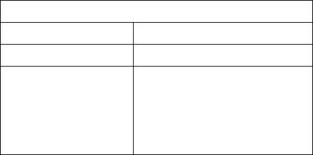
SEBU8352
35
Maintenance Section
Refill Capacities
• Freezing
NOTICE
• Cavitation of the water pump
Do not use a commercial coolant/antifreeze that on-
ly meets the ASTM D3306 specification. This type of
coolant/antifreeze is made for light automotive appli-
cations.
For optimum performance, Perkins recommends a
1:1 mixture of a water/glycol solution.
Note: Use a mixture that will provide protection
against the lowest ambient temperature.
Perkins recommends a 1:1 mixture of water and
glycol. This mixture of water and glycol will provide
optimum heavy-duty performance as a antifreeze.
This ratio may be increased to 1:2 water to glycol if
extra freezing protection is required.
Note: 100 percent pure glycol will freeze at a
temperature of −23 °C (−9 °F).
Most conventional antifreezes use ethylene glycol.
Propylene glycol may also be used. In a 1:1 mixture
with water, ethylene and propylene glycol provide
similar protection against freezing and boiling. See
Tables 7 and 8.
Note: A commercial heavy-duty antifreeze that
meets “ASTM D4985” specifications MAY require a
treatment with an SCA at the initial fill. Read the label
or the instructions that are provided by the OEM of
the product.
Table 7
In stationary engine applications and marine engine
applications that do not require anti-boil protection
or freeze protection, a mixture of SCA and water
is acceptable. Perkins recommends a six percent
to eight percent concentration of SCA in those
cooling systems. Distilled water or deionized water
is preferred. Water which has the recommended
properties may be used.
Ethylene Glycol
Freeze
Protection
Boil
Protection
Concentration
50 Percent
60 Percent
−36 °C (−33 °F) 106 °C (223 °F)
−51 °C (−60 °F) 111 °C (232 °F)
NOTICE
Engines that are operating in an ambient temperature
above 43 °C (109.4 °F) must use SCA and water.
Engines that operate in an ambient temperature
above 43 °C (109.4 °F) and below 0 °C (32 °F) due
to seasonal variations consult your Perkins dealer
or your Perkins distributor for the correct level of
protection.
Do not use propylene glycol in concentrations that ex-
ceed 50 percent glycol because of propylene glycol’s
reduced heat transfer capability. Use ethylene glycol
in conditions that require additional protection against
boiling or freezing.
Table 8
Table 9
Propylene Glycol
Coolant Service Life
Freeze
Protection
Anti-Boil
Protection
Concentration
Coolant Type
Service Life
6,000 Service Hours or
Three Years
50 Percent
−29 °C (−20 °F) 106 °C (223 °F)
Perkins ELC
Commercial Heavy-Duty
Antifreeze that meets
“ASTM D4985”
To check the concentration of glycol in the coolant,
measure the specific gravity of the coolant.
3000 Service Hours or
Two Years
Coolant Recommendations
Perkins POWERPART
SCA
3000 Service Hours or
Two Years
The following two coolants are used in Perkins diesel
engines:
Commercial SCA and
Water
3000 Service Hours or
Two Years
Preferred – Perkins Extended Life Coolant (ELC)
Extended Life Coolant (ELC)
Acceptable – A commercial heavy-duty antifreeze
that meets “ASTM D4985” specifications
Perkins provides Extended Life Coolant (ELC) for
use in the following applications:
• Heavy-duty spark ignited gas engines
• Heavy-duty diesel engines
This document has been printed from SPI². Not for Resale
![]()

![]()
![]()

![]()
![]()
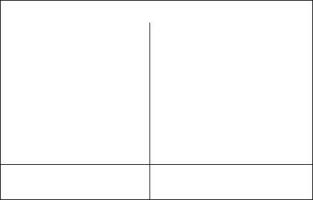
36
SEBU8352
Maintenance Section
Refill Capacities
• Automotive applications
ELC Cooling System Cleaning
The anti-corrosion package for ELC is different from
the anti-corrosion package for other coolants. ELC
is an ethylene glycol base coolant. However, ELC
contains organic corrosion inhibitors and antifoam
agents with low amounts of nitrite. Perkins ELC
has been formulated with the correct amount of
these additives in order to provide superior corrosion
protection for all metals in engine cooling systems.
Note: If the cooling system is already using ELC,
cleaning agents are not required to be used at
the specified coolant change interval. Cleaning
agents are only required if the system has been
contaminated by the addition of some other type of
coolant or by cooling system damage.
Clean water is the only cleaning agent that is required
when ELC is drained from the cooling system.
ELC is available in a 1:1 premixed cooling solution
with distilled water. The Premixed ELC provides
freeze protection to −36 °C (−33 °F). The Premixed
ELC is recommended for the initial fill of the cooling
system. The Premixed ELC is also recommended for
topping off the cooling system.
After the cooling system is drained and after the
cooling system is refilled, operate the engine while
the cooling system filler cap is removed. Operate
the engine until the coolant level reaches the normal
operating temperature and until the coolant level
stabilizes. As needed, add the coolant mixture in
order to fill the system to the specified level.
ELC Concentrate is also available. ELC Concentrate
can be used to lower the freezing point to −51 °C
(−60 °F) for arctic conditions.
Changing to Perkins ELC
Containers of several sizes are available. Consult
your Perkins dealer or your Perkins distributor for the
part numbers.
To change from heavy-duty antifreeze to the Perkins
ELC, perform the following steps:
NOTICE
ELC Cooling System Maintenance
Care must be taken to ensure that all fluids are
contained during performance of inspection, main-
tenance, testing, adjusting and the repair of the
product. Be prepared to collect the fluid with suitable
containers before opening any compartment or dis-
assembling any component containing fluids.
Correct additions to the Extended Life
Coolant
NOTICE
Use only Perkins products for pre-mixed or concen-
trated coolants.
Dispose of all fluids according to local regulations and
mandates.
Mixing Extended Life Coolant with other products re-
duces the Extended Life Coolant service life. Failure to
follow the recommendations can reduce cooling sys-
tem components life unless appropriate corrective ac-
tion is performed.
1. Drain the coolant into a suitable container.
2. Dispose of the coolant according to local
regulations.
3. Flush the system with clean water in order to
remove any debris.
In order to maintain the correct balance between
the antifreeze and the additives, you must maintain
the recommended concentration of Extended Life
Coolant (ELC). Lowering the proportion of antifreeze
lowers the proportion of additive. This will lower the
ability of the coolant to protect the system from pitting,
from cavitation, from erosion, and from deposits.
4. Use Perkins cleaner to clean the system. Follow
the instruction on the label.
5. Drain the cleaner into a suitable container. Flush
the cooling system with clean water.
NOTICE
Do not use a conventional coolant to top-off a cooling
system that is filled with Extended Life Coolant (ELC).
6. Fill the cooling system with clean water and
operate the engine until the engine is warmed to
49° to 66°C (120° to 150°F).
Do not use standard supplemental coolant additive
(SCA).
When using Perkins ELC, do not use standard SCA’s
or SCA filters.
This document has been printed from SPI². Not for Resale
![]()
![]()
![]()
![]()
![]()
![]()
![]()
SEBU8352
37
Maintenance Section
Refill Capacities
Commercial Heavy-Duty Antifreeze and
SCA
NOTICE
Incorrect or incomplete flushing of the cooling system
can result in damage to copper and other metal com-
ponents.
NOTICE
Commercial Heavy-Duty Coolant which contains
Amine as part of the corrision protection system must
not be used.
To avoid damage to the cooling system, make sure to
completely flush the cooling system with clear water.
Continue to flush the system until all the signs of the
cleaning agent are gone.
NOTICE
Never operate an engine without water temperature
regulators in the cooling system. Water temperature
regulators help to maintain the engine coolant at the
correct operating temperature. Cooling system prob-
lems can develop without water temperature regula-
tors.
7. Drain the cooling system into a suitable container
and flush the cooling system with clean water.
Note: The cooling system cleaner must be thoroughly
flushed from the cooling system. Cooling system
cleaner that is left in the system will contaminate the
coolant. The cleaner may also corrode the cooling
system.
Check the antifreeze (glycol concentration) in
order to ensure adequate protection against boiling
or freezing. Perkins recommends the use of a
refractometer for checking the glycol concentration.
8. Repeat Steps 6 and 7 until the system is
completely clean.
Perkins engine cooling systems should be tested
at 500 hour intervals for the concentration of
Supplemental Coolant Additive (SCA).
9. Fill the cooling system with the Perkins Premixed
ELC.
Additions of SCA are based on the results of the test.
An SCA that is liquid may be needed at 500 hour
intervals.
ELC Cooling System Contamination
NOTICE
Mixing ELC with other products reduces the effective-
ness of the ELC and shortens the ELC service life.
Use only Perkins Products for premixed or concen-
trate coolants. Failure to follow these recommenda-
tions can result in shortened cooling system compo-
nent life.
Refer to Table 10 for part numbers and for quantities
of SCA.
Table 10
Perkins Liquid SCA
Part Number
Quantity
ELC cooling systems can withstand contamination to
a maximum of ten percent of conventional heavy-duty
antifreeze or SCA. If the contamination exceeds ten
percent of the total system capacity, perform ONE of
the following procedures:
21825735
10
Adding the SCA to Heavy-Duty Coolant
at the Initial Fill
• Drain the cooling system into a suitable container.
Dispose of the coolant according to local
regulations. Flush the system with clean water. Fill
the system with the Perkins ELC.
Commercial heavy-duty antifreeze that meets “ASTM
D4985” specifications MAY require an addition of
SCA at the initial fill. Read the label or the instructions
that are provided by the OEM of the product.
• Drain a portion of the cooling system into a suitable
container according to local regulations. Then, fill
the cooling system with premixed ELC. This should
lower the contamination to less than 10 percent.
Use the equation that is in Table 11 to determine the
amount of Perkins SCA that is required when the
cooling system is initially filled.
Table 11
• Maintain the system as a conventional Heavy-Duty
Coolant. Treat the system with an SCA. Change
the coolant at the interval that is recommended for
the conventional Heavy-Duty Coolant.
Equation For Adding The SCA To The Heavy-Duty
Coolant At The Initial Fill
V × 0.045 = X
V is the total volume of the cooling system.
X is the amount of SCA that is required.
This document has been printed from SPI². Not for Resale
![]()
![]()
![]()
![]()
![]()
![]()
![]()
![]()
![]()


38
SEBU8352
Maintenance Section
Refill Capacities
Table 12 is an example for using the equation that
is in Table 11.
Cleaning the System of Heavy-Duty
Antifreeze
Table 12
Perkins cooling system cleaners are designed
to clean the cooling system of harmful scale
and corrosion. Perkins cooling system cleaners
dissolve mineral scale, corrosion products, light oil
contamination and sludge.
Example Of The Equation For Adding The SCA To
The Heavy-Duty Coolant At The Initial Fill
Total Volume
of the Cooling
System (V)
Multiplication
Factor
Amount of SCA
that is Required
(X)
• Clean the cooling system after used coolant is
drained or before the cooling system is filled with
new coolant.
15 L (4 US gal)
× 0.045
0.7 L (24 oz)
Adding The SCA to The Heavy-Duty
Coolant For Maintenance
• Clean the cooling system whenever the coolant is
contaminated or whenever the coolant is foaming.
Heavy-duty antifreeze of all types REQUIRE periodic
additions of an SCA.
i02883885
Fluid Recommendations
Test the antifreeze periodically for the concentration
of SCA. For the interval, refer to the Operation
and Maintenance Manual, “Maintenance Interval
Schedule” (Maintenance Section). Test the
concentration of SCA.
General Lubricant Information
Additions of SCA are based on the results of the
test. The size of the cooling system determines the
amount of SCA that is needed.
Because of government regulations regarding the
certification of exhaust emissions from the engine,
the lubricant recommendations must be followed.
Use the equation that is in Table 13 to determine the
amount of Perkins SCA that is required, if necessary:
Engine Manufacturers Association (EMA)
Oils
Table 13
The “Engine Manufacturers Association
Recommended Guideline on Diesel Engine Oil” is
recognized by Perkins. For detailed information
about this guideline, see the latest edition of EMA
publication, “EMA DHD -1”.
Equation For Adding The SCA To The Heavy-Duty
Coolant For Maintenance
V × 0.014 = X
V is the total volume of the cooling system.
X is the amount of SCA that is required.
API Oils
The Engine Oil Licensing and Certification System by
the American Petroleum Institute (API) is recognized
by Perkins. For detailed information about this
system, see the latest edition of the “API publication
No. 1509”. Engine oils that bear the API symbol are
authorized by API.
Table 14 is an example for using the equation that
is in Table 13.
Table 14
Example Of The Equation For Adding The SCA To
The Heavy-Duty Coolant For Maintenance
Total Volume
of the Cooling
System (V)
Multiplication
Factor
Amount of SCA
that is Required
(X)
15 L (4 US gal)
× 0.014
0.2 L (7 oz)
This document has been printed from SPI². Not for Resale
![]()
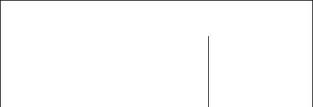

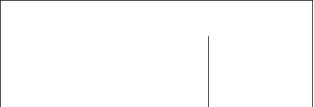
SEBU8352
39
Maintenance Section
Refill Capacities
In order to make the correct choice of a commercial
oil, refer to the following explanations:
EMA DHD-1 – The Engine Manufacturers
Association (EMA) has developed lubricant
recommendations as an alternative to the API oil
classification system. DHD-1 is a Recommended
Guideline that defines a level of oil performance for
these types of diesel engines: high speed, four stroke
cycle, heavy-duty, and light duty. DHD-1 oils may
be used in Perkins engines when the following oils
are recommended: API CH-4, API CG-4, and API
CF-4. DHD-1 oils are intended to provide superior
performance in comparison to API CG-4 and API
CF-4.
g00546535
Illustration 18
Typical API symbol
DHD-1 oils will meet the needs of high performance
Perkins diesel engines that are operating in many
applications. The tests and the test limits that are
used to define DHD-1 are similar to the new API
CH-4 classification. Therefore, these oils will also
meet the requirements for diesel engines that require
low emissions. DHD-1 oils are designed to control the
harmful effects of soot with improved wear resistance
and improved resistance to plugging of the oil filter.
These oils will also provide superior control of piston
deposits for engines with either two-piece steel
pistons or aluminum pistons.
Diesel engine oils CC, CD, CD-2, and CE have
not been API authorized classifications since 1
January 1996. Table 15 summarizes the status of
the classifications.
Table 15
API Classifications
Current
CH-4, , CI-4
-
Obsolete
CE, CC, CD
CD-2 (1)
All DHD-1 oils must complete a full test program
with the base stock and with the viscosity grade of
the finished commercial oil. The use of “API Base
Oil Interchange Guidelines” are not appropriate for
DHD-1 oils. This feature reduces the variation in
performance that can occur when base stocks are
changed in commercial oil formulations.
(1) The oil CD-2 is for a two-cycle diesel engine. Perkins does not
sell engines that utilize CD-2 oil.
Terminology
Certain abbreviations follow the nomenclature of
“SAE J754”. Some classifications follow “SAE J183”
abbreviations, and some classifications follow the
“EMA Recommended Guideline on Diesel Engine
Oil”. In addition to Perkins definitions, there are other
definitions that will be of assistance in purchasing
lubricants. Recommended oil viscosities can be found
in this publication, “Fluid Recommendations/Engine
Oil” topic (Maintenance Section).
DHD-1 oils are recommended for use in extended oil
change interval programs that optimize the life of the
oil. These oil change interval programs are based
on oil analysis. DHD-1 oils are recommended for
conditions that demand a premium oil. Your Perkins
dealer or your Perkins distributor has the specific
guidelines for optimizing oil change intervals.
API CH-4 – API CH-4 oils were developed in order to
meet the requirements of the new high performance
diesel engines. Also, the oil was designed to
meet the requirements of the low emissions diesel
engines. API CH-4 oils are also acceptable for use
in older diesel engines and in diesel engines that
use high sulfur diesel fuel. API CH-4 oils may be
used in Perkins engines that use API CG-4 and API
CF-4 oils. API CH-4 oils will generally exceed the
performance of API CG-4 oils in the following criteria:
deposits on pistons, control of oil consumption, wear
of piston rings, valve train wear, viscosity control,
and corrosion.
Engine Oil
Commercial Oils
The performance of commercial diesel engine
oils is based on American Petroleum Institute
(API) classifications. These API classifications are
developed in order to provide commercial lubricants
for a broad range of diesel engines that operate at
various conditions.
Only use commercial oils that meet the following
classifications:
• API CH-4 CI-4
This document has been printed from SPI². Not for Resale
![]()
![]()
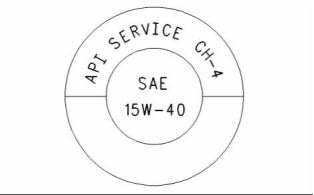

40
SEBU8352
Maintenance Section
Refill Capacities
Three new engine tests were developed for the API
CH-4 oil. The first test specifically evaluates deposits
on pistons for engines with the two-piece steel piston.
This test (piston deposit) also measures the control
of oil consumption. A second test is conducted
with moderate oil soot. The second test measures
the following criteria: wear of piston rings, wear of
cylinder liners, and resistance to corrosion. A third
new test measures the following characteristics with
high levels of soot in the oil: wear of the valve train,
resistance of the oil in plugging the oil filter, and
control of sludge.
In addition to the new tests, API CH-4 oils have
tougher limits for viscosity control in applications that
generate high soot. The oils also have improved
oxidation resistance. API CH-4 oils must pass an
additional test (piston deposit) for engines that use
aluminum pistons (single piece). Oil performance is
also established for engines that operate in areas
with high sulfur diesel fuel.
g00799818
Illustration 19
(Y) TBN by “ASTM D2896”
(X) Percentage of fuel sulfur by weight
(1) TBN of new oil
(2) Change the oil when the TBN deteriorates to 50 percent of
the original TBN.
Use the following guidelines for fuel sulfur levels that
exceed 1.5 percent:
All of these improvements allow the API CH-4
oil to achieve optimum oil change intervals. API
CH-4 oils are recommended for use in extended oil
change intervals. API CH-4 oils are recommended
for conditions that demand a premium oil. Your
Perkins dealer or your Perkins distributor has specific
guidelines for optimizing oil change intervals.
•
•
Choose an oil with the highest TBN that meets one
of these classifications: EMA DHD-1 and API CH-4.
Reduce the oil change interval. Base the oil
change interval on the oil analysis. Ensure that the
oil analysis includes the condition of the oil and a
wear metal analysis.
Some commercial oils that meet the API
classifications may require reduced oil change
intervals. To determine the oil change interval, closely
monitor the condition of the oil and perform a wear
metal analysis.
Excessive piston deposits can be produced by an oil
with a high TBN. These deposits can lead to a loss
of control of the oil consumption and to the polishing
of the cylinder bore.
NOTICE
Failure to follow these oil recommendations can cause
shortened engine service life due to deposits and/or
excessive wear.
NOTICE
Operating Direct Injection (DI) diesel engines with fuel
sulphur levels over 0.5 percent will require shortened
oil change intervals in order to help maintain adequate
wear protection.
Total Base Number (TBN) and Fuel Sulfur
Levels for Direct Injection (DI) Diesel
Engines
Table 16
Percentage of Sulfur in
the fuel
Oil change interval
The Total Base Number (TBN) for an oil depends on
the fuel sulfur level. For direct injection engines that
use distillate fuel, the minimum TBN of the new oil
must be 10 times the fuel sulfur level. The TBN is
defined by “ASTM D2896”. The minimum TBN of the
oil is 5 regardless of fuel sulfur level. Illustration 19
demonstrates the TBN.
Lower than 0.5
0.5 to 1.0
Normal
0.75 of normal
0.50 of normal
Greater than 1.0
Lubricant Viscosity Recommendations
for Direct Injection (DI) Diesel Engines
The correct SAE viscosity grade of oil is determined
by the minimum ambient temperature during
cold engine start-up, and the maximum ambient
temperature during engine operation.
This document has been printed from SPI². Not for Resale
![]()
![]()
![]()
![]()
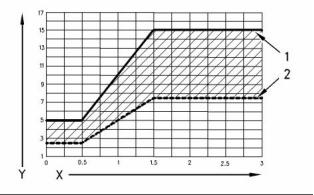
![]()
![]()

SEBU8352
41
Maintenance Section
Refill Capacities
Refer to Table 17 (minimum temperature) in order
to determine the required oil viscosity for starting a
cold engine.
Re-refined Base Stock Oils
Re-refined base stock oils are acceptable for
use in Perkins engines if these oils meet the
performance requirements that are specified by
Perkins. Re-refined base stock oils can be used
exclusively in finished oil or in a combination with
new base stock oils. The US military specifications
and the specifications of other heavy equipment
manufacturers also allow the use of re-refined base
stock oils that meet the same criteria.
Refer to Table 17 (maximum temperature) in order
to select the oil viscosity for engine operation at the
highest ambient temperature that is anticipated.
Generally, use the highest oil viscosity that is
available to meet the requirement for the temperature
at start-up.
Table 17
The process that is used to make re-refined base
stock oil should adequately remove all wear metals
that are in the used oil and all the additives that
are in the used oil. The process that is used to
make re-refined base stock oil generally involves the
process of vacuum distillation and hydrotreating the
used oil. Filtering is adequate for the production of
high quality, re-refined base stock oil.
Engine Oil Viscosity
EMA LRG-1
API CH-4
Viscosity Grade
Ambient Temperature
Minimum
Maximum
SAE 0W20
SAE 0W30
SAE 0W40
SAE 5W30
SAE 5W40
SAE 10W30
SAE 15W40
−40 °C (−40 °F)
−40 °C (−40 °F)
−40 °C (−40 °F)
−30 °C (−22 °F)
−30 °C (−22 °F)
−20 °C (−4 °F)
−10 °C (14 °F)
10 °C (50 °F)
30 °C (86 °F)
40 °C (104 °F)
30 °C (86 °F)
40 °C (104 °F)
40 °C (104 °F)
50 °C (122 °F)
Lubricants for Cold Weather
When an engine is started and an engine is operated
in ambient temperatures below −20 °C (−4 °F), use
multigrade oils that are capable of flowing in low
temperatures.
These oils have lubricant viscosity grades of SAE
0W or SAE 5W.
Synthetic Base Stock Oils
When an engine is started and operated in ambient
temperatures below −30 °C (−22 °F), use a synthetic
base stock multigrade oil with an 0W viscosity grade
or with a 5W viscosity grade. Use an oil with a pour
point that is lower than −50 °C (−58 °F).
Synthetic base oils are acceptable for use in
these engines if these oils meet the performance
requirements that are specified for the engine.
Synthetic base oils generally perform better than
conventional oils in the following two areas:
The number of acceptable lubricants is limited in
cold weather conditions. Perkins recommends the
following lubricants for use in cold weather conditions:
• Synthetic base oils have improved flow at low
temperatures especially in arctic conditions.
First Choice – Use oil with an EMA DHD-1
Recommended Guideline. Use a CH-4 oil that has
an API license. The oil should be either SAE 0W20,
SAE 0W30, SAE 0W40, SAE 5W30, or SAE 5W40
lubricant viscosity grade.
• Synthetic base oils have improved oxidation
stability especially at high operating temperatures.
Some synthetic base oils have performance
characteristics that enhance the service life of the
oil. Perkins does not recommend the automatic
extending of the oil change intervals for any type of
oil.
Second Choice – Use an oil that has a CH-4
additive package. Although the oil has not been
tested for the requirements of the API license, the oil
must be either SAE 0W20, SAE 0W30, SAE 0W40,
SAE 5W30, or SAE 5W40.
NOTICE
Shortened engine service life could result if second
choice oils are used.
This document has been printed from SPI². Not for Resale
![]()
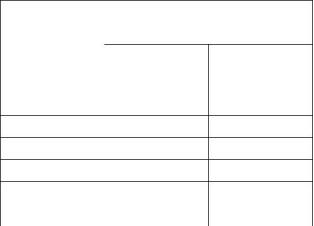
![]()
![]()
42
SEBU8352
Maintenance Section
Refill Capacities
Aftermarket Oil Additives
• Tests are conducted in order to detect
contamination of the oil by water, glycol or fuel.
Perkins does not recommend the use of aftermarket
additives in oil. It is not necessary to use aftermarket
additives in order to achieve the engine’s maximum
service life or rated performance. Fully formulated,
finished oils consist of base oils and of commercial
additive packages. These additive packages are
blended into the base oils at precise p, ercentages in
order to help provide finished oils with performance
characteristics that meet industry standards.
• The Oil Condition Analysis determines the loss of
the oil’s lubricating properties. An infrared analysis
is used to compare the properties of new oil to the
properties of the used oil sample. This analysis
allows technicians to determine the amount of
deterioration of the oil during use. This analysis
also allows technicians to verify the performance
of the oil according to the specification during the
entire oil change interval.
There are no industry standard tests that evaluate
the performance or the compatibility of aftermarket
additives in finished oil. Aftermarket additives may
not be compatible with the finished oil’s additive
package, which could lower the performance of the
finished oil. The aftermarket additive could fail to
mix with the finished oil. This could produce sludge
in the crankcase. Perkins discourages the use of
aftermarket additives in finished oils.
i02883936
Fluid Recommendations
Fuel Specifications
To achieve the best performance from a Perkins
engine, conform to the following guidelines:
Fuel Recommendations
To get the correct power and performance from
the engine, use a fuel of the correct quality. The
recommended fuel specification for Perkins engines
is shown below:
• Select the correct oil, or a commercial oil that meets
the “EMA Recommended Guideline on Diesel
Engine Oil” or the recommended API classification.
• See the appropriate “Lubricant Viscosities” table in
order to find the correct oil viscosity grade for your
engine.
• Cetane number___________________________45 minimum
• Viscosity___________2,0 to 4.5 cSt at 40 °C (104 °F)
• Density________________________0.835 to 0.855 Kg/liter
• Sulfur_______________________0.2% of mass, maximum
• Distillation___________________85% at 350 °C (662 °F)
• At the specified interval, service the engine. Use
new oil and install a new oil filter.
• Perform maintenance at the intervals that are
specified in the Operation and Maintenance
Manual, “Maintenance Interval Schedule”.
• Lubricity______________________________460 micrometers
maximum wear scar on “ISO 12156 - 1”
Oil analysis
Cetane number
Some engines may be equipped with an oil sampling
valve. If oil analysis is required the oil sampling valve
is used to obtain samples of the engine oil. The oil
analysis will complement the preventive maintenance
program.
This indicates the properties of ignition of the fuel.
Fuel with a low cetane number can be the root
cause of problems during cold start. This will affect
combustion.
The oil analysis is a diagnostic tool that is used to
determine oil performance and component wear
rates. Contamination can be identified and measured
through the use of the oil analysis. The oil analysis
includes the following tests:
Viscosity
This is the resistance to flow of a fluid. If this
resistance is outside the limits, the engine and the
engine starting performance in particular can be
affected.
• The Wear Rate Analysis monitors the wear of the
engine’s metals. The amount of wear metal and
type of wear metal that is in the oil is analyzed. The
increase in the rate of engine wear metal in the
oil is as important as the quantity of engine wear
metal in the oil.
Sulfur
This document has been printed from SPI². Not for Resale
![]()
SEBU8352
43
Maintenance Section
Refill Capacities
High sulfur content of the fuel is not normally found
in Europe, North America or Australasia. This can
cause engine wear. When only high sulfur fuels
are available, it will be necessary that high alkaline
lubricating oil is used in the engine or that the
lubricating oil change interval is reduced.
“ASTM D975 - 91 Class 1D”
“JP7, Mil T38219”
“NATO F63”
NOTICE
These fuels should have a wear scar value of 650
Distillation
micrometers maximum *HFRR to ISO 12156 - 1.*
This is an indication of the mixture of different
hydrocarbons in the fuel. A high ratio of light weight
hydrocarbons can affect the characteristics of
combustion.
Group 3 (aviation kerosene fuels): Specification
These fuels need additives to achieve lubricity of 650
micrometers wear scar and the reliability of the fuel
pump and fuel injectors will be reduced. The fuel
injection pump is not covered by a warranty, even
when the additives are included.
Lubricity
This is the capability of the fuel to prevent pump wear.
Diesel engines have the ability to burn a wide variety
of fuels. These fuels are divided into four general
groups:
“JP5 MIL T5624 (Avcat FSII, NATO F44”
“JP8 T83133 (Avtur FSII, NATO F34”
“Jet A”
• Group 1 (preferred fuels)
• Group 2 (permissible fuels)
• Group 3 (aviation kerosene fuels)
• Other fuels
“Jet A1, NATO F35, XF63”
Low temperature fuels
Special fuels for use in cold weather may be available
for engine operation at temperatures below 0 °C
(32 °F). These fuels limit the formation of wax in the
fuel oil at low temperatures. If wax forms in the fuel
oil, this could stop the flow of fuel oil through the filter.
Group 1 (preferred fuels): Specification
“DERV to EN590”
Note: Only use Arctic fuels when the temperature is
below 0 °C (32 °F). Do not use Arctic fuels when the
ambient temperature is above 0 °C (32 °F). To ensure
that the time period between cranking the engine and
first fire is kept to a minimum, only use fuel of the
correct viscosity and at the correct temperature.
Note: These fuels that lack lubricity may cause the
following problems:
• Low engine power
• Difficult starting in hot conditions or in cold
conditions
Gas oil to “BS2869 Class A2”
• White smoke
“ASTM D975 - 91 Class 2D” This can only be used if
the fuel has the correct specification of lubricity.
• Deterioration of emissions and misfire at certain
operating conditions
“JIS K2204 (1992) Grades 1,2,3 and Special Grade
3” This can only be used if the fuel has the correct
specification of lubricity.
Biofuel: Specification
Biofuel: A 5% mix of RME to EN14214 in conventional
fuel is permitted.
Note: If low sulfur or low sulfur aromatic fuels are
used, then fuel additives can be used to increase
lubricity.
NOTICE
Water emulsion fuels: These fuels are not permitted
Group 2 (permissible fuels): Specification
These fuel specifications are considered acceptable
for issues of warranty. However,these fuels may
reduce the life of the engine, the engine’s maximum
power and the engine’s fuel efficiency.
Refer to the following fuel specifications for
North America.
This document has been printed from SPI². Not for Resale
![]()
![]()
![]()
![]()
![]()
44
SEBU8352
Maintenance Section
Refill Capacities
The preferred fuels provide maximum engine service
life and performance. The preferred fuels are distillate
fuels. These fuels are commonly called diesel fuel
or gas oil.
(Table 18, contd)
Copper Strip
Corrosion
No. 3 maximum
“D130”
“D86”
10% at 282 °C
(540 °F)
maximum
The permissible fuels are crude oils or blended fuels.
Use of these fuels can result in higher maintenance
costs and in reduced engine service life.
Distillation
90% at 360 °C
(680 °F)
Diesel fuels that meet the specifications in Table
18 will help to provide maximum engine service life
and performance. In North America, diesel fuel that
is identified as No. 2-D in “ASTM D975” generally
meets the specifications. Table 18 is for diesel fuels
that are distilled from crude oil. Diesel fuels from
other sources could exhibit detrimental properties
that are not defined or controlled by this specification.
maximum
Flash Point
API Gravity
legal limit
“D93”
30 minimum
45 maximum
“D287”
6 °C (10 °F)
minimum
below ambient
temperature
Pour Point
“D97”
Table 18
Perkins Specifications for Distillate Diesel Fuel
0.2% maximum
“D3605”
or
“D1552”
Sulfur
(1)
Specifications
Requirements
ASTM Test
Aromatics
35% maximum
“D1319”
2.0 cSt minimum
and 4.5 cSt
maximum at
Kinematic
Viscosity (2)
0.02% maximum
(weight)
“D445”
Ash
“D482”
“D524”
40 °C (104 °F)
Carbon Residue
on 10% Bottoms
0.35% maximum
(weight)
Water and
Sediment
0.1% maximum
“D1796”
“D1744”
“D473”
40 minimum (DI
engines)
Cetane Number
“D613”
Water
0.1% maximum
0.05% maximum
(weight)
Sediment
The cloud
point must not
exceed the
lowest expected
ambient
Gum and Resins 10 mg per 100
(3)
Cloud Point
-
“D381”
mL maximum
0.38 mm
temperature.
(0.015 inch)
maximum at
25 °C (77 °F)
Lubricity
(4)
“D6079”
(continued)
(1) Perkins fuel systems and engine components can operate
on high sulfur fuels. Fuel sulfur levels affect exhaust
emissions. High sulfur fuels also increase the potential
for corrosion of internal components. Fuel sulfur levels
above 0.5 percent may significantly shorten the oil change
interval. For additional information, see this publication, “Fluid
Recommendations/Engine Oil” topic (Maintenance Section).
(2) The values of the fuel viscosity are the values as the fuel
is delivered to the fuel injection pumps. If a fuel with a low
viscosity is used, cooling of the fuel may be required to maintain
a 1.4 cSt viscosity at the fuel injection pump. Fuels with a high
viscosity might require fuel heaters in order to bring down the
viscosity to a 20 cSt viscosity.
(3) Follow the test conditions and procedures for gasoline (motor).
(4) The lubricity of a fuel is a concern with low sulfur fuel. To
determine the lubricity of the fuel, use either the “ASTM D6078
Scuffing Load Wear Test (SBOCLE)” or the “ASTM D6079 High
Frequency Reciprocating Rig (HFRR)” test. If the lubricity of a
fuel does not meet the minimum requirements, consult your
fuel supplier. Do not treat the fuel without consulting the fuel
supplier. Some additives are not compatible. These additives
can cause problems in the fuel system.
This document has been printed from SPI². Not for Resale
![]()
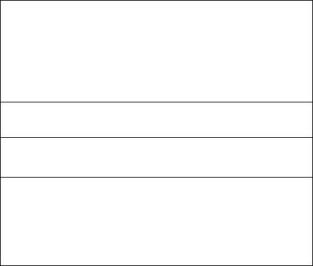
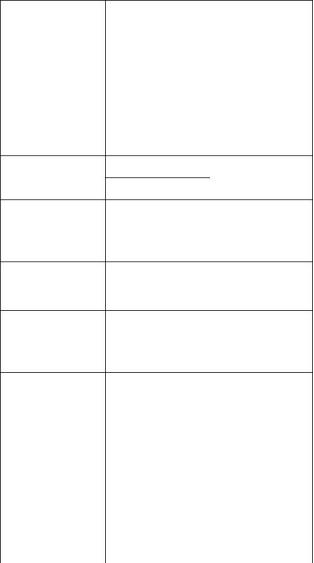
SEBU8352
45
Maintenance Section
Refill Capacities
NOTICE
Operating with fuels that do not meet the Perkins rec-
ommendations can cause the following effects: Start-
ing difficulty, poor combustion, deposits in the fuel in-
jectors, reduced service life of the fuel system, de-
posits in the combustion chamber, and reduced ser-
vice life of the engine.
NOTICE
Heavy Fuel Oil (HFO), Residual fuel, or Blended fuel
must NOT be used in Perkins diesel engines. Severe
component wear and component failures will result if
HFO type fuels are used in engines that are configured
to use distillate fuel.
In extreme cold ambient conditions, you may use the
distillate fuels that are specified in Table 19. However,
the fuel that is selected must meet the requirements
that are specified in Table 18. These fuels are
intended to be used in operating temperatures that
are down to −54 °C (−65 °F).
Table 19
Distillate Fuels
(1)
Specification
“MIL-T-5624R”
“ASTM D1655”
“MIL-T-83133D”
Grade
JP-5
Jet-A-1
JP-8
(1) The fuels that are listed in this Table may not meet the
requirements that are specified in the “Perkins Specifications
for Distillate Diesel Fuel” Table. Consult the supplier for the
recommended additives in order to maintain the correct fuel
lubricity.
These fuels are lighter than the No. 2 grades of fuel.
The cetane number of the fuels in Table 19 must be
at least 40. If the viscosity is below 1.4 cSt at 38 °C
(100 °F), use the fuel only in temperatures below
0 °C (32 °F). Do not use any fuels with a viscosity
of less than 1.2 cSt at 38 °C (100 °F). Fuel cooling
may be required in order to maintain the minimum
viscosity of 1.4 cSt at the fuel injection pump.
There are many other diesel fuel specifications that
are published by governments and by technological
societies. Usually, those specifications do not
review all the requirements that are addressed
in this specification. To ensure optimum engine
performance, a complete fuel analysis should be
obtained before engine operation. The fuel analysis
should include all of the properties that are listed in
Table 18.
This document has been printed from SPI². Not for Resale
![]()
![]()
![]()
![]()
![]()
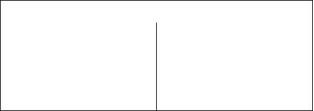
46
SEBU8352
Maintenance Section
Maintenance Interval Schedule
i02818827
Every 4000 Service Hours
Maintenance Interval Schedule
Aftercooler Core - Clean/Test ............................... 47
Every 6000 Service Hours or 3 Years
Cooling System Coolant Extender (ELC) - Add .... 53
When Required
Battery - Replace .................................................. 49
Battery or Battery Cable - Disconnect .................. 50
Engine - Clean ...................................................... 55
Engine Air Cleaner Element (Dual Element) -
Every 12 000 Service Hours or 6 Years
Cooling System Coolant (ELC) - Change ............. 52
Clean/Replace .................................................... 55
Engine Air Cleaner Element (Single Element) -
Inspect/Replace .................................................. 57
Engine Oil Sample - Obtain .................................. 59
Fuel Injector - Test/Change ................................... 62
Fuel System - Prime ............................................. 63
Severe Service Application - Check ..................... 68
Daily
Alternator and Fan Belts - Inspect/Adjust/Replace
Cooling System Coolant Level - Check ................ 53
Driven Equipment - Check .................................... 54
Engine Air Cleaner Service Indicator - Inspect ..... 57
Engine Oil Level - Check ...................................... 58
Fuel System Primary Filter/Water Separator -
Drain ................................................................... 64
Walk-Around Inspection ........................................ 70
Every 500 Service Hours or 1 Year
Battery Electrolyte Level - Check .......................... 49
Engine Air Cleaner Element (Dual Element) -
Clean/Replace .................................................... 55
Engine Air Cleaner Element (Single Element) -
Inspect/Replace .................................................. 57
Engine Oil and Filter - Change ............................. 59
Fuel System Primary Filter (Water Separator)
Element - Replace .............................................. 65
Fuel System Secondary Filter - Replace .............. 65
Hoses and Clamps - Inspect/Replace .................. 66
Radiator - Clean .................................................... 67
Every 1000 Service Hours
Engine Valve Lash - Inspect/Adjust ...................... 61
Every 2000 Service Hours
Aftercooler Core - Inspect ..................................... 47
Alternator - Inspect ............................................... 48
Engine Mounts - Inspect ....................................... 58
Starting Motor - Inspect ........................................ 69
Turbocharger - Inspect .......................................... 69
Water Pump - Inspect ........................................... 71
Every 3000 Service Hours or 2 Years
Cooling System Coolant (Commercial Heavy-Duty) -
Change ............................................................... 50
This document has been printed from SPI². Not for Resale
![]()

SEBU8352
47
Maintenance Section
Aftercooler Core - Clean/Test
i02690449
Aftercooler Core - Clean/Test
Personal injury can result from air pressure.
Personal injury can result without following prop-
er procedure. When using pressure air, wear a pro-
tective face shield and protective clothing.
1. Remove the core. Refer to the OEM information
for the correct procedure.
Maximum air pressure at the nozzle must be less
than 205 kPa (30 psi) for cleaning purposes.
2. Turn the aftercooler core upside-down in order to
remove debris.
8. Dry the core with compressed air. Direct the air in
the reverse direction of the normal flow.
Personal injury can result from air pressure.
9. Inspect the core in order to ensure cleanliness.
Pressure test the core. If necessary, repair the
core.
Personal injury can result without following prop-
er procedure. When using pressure air, wear a pro-
tective face shield and protective clothing.
10. Install the core. Refer to the OEM information for
Maximum air pressure at the nozzle must be less
than 205 kPa (30 psi) for cleaning purposes.
the correct procedure.
11. After cleaning, start the engine and accelerate
the engine to high idle rpm. This will help in the
removal of debris and drying of the core. Stop the
engine. Use a light bulb behind the core in order
to inspect the core for cleanliness. Repeat the
cleaning, if necessary.
3. Pressurized air is the preferred method for
removing loose debris. Direct the air in the
opposite direction of the fan’s air flow. Hold the
nozzle approximately 6 mm (.25 inch) away from
the fins. Slowly move the air nozzle in a direction
that is parallel with the tubes. This will remove
debris that is between the tubes.
i02690450
Aftercooler Core - Inspect
4. Pressurized water may also be used for cleaning.
The maximum water pressure for cleaning
purposes must be less than 275 kPa (40 psi). Use
pressurized water in order to soften mud. Clean
the core from both sides.
Note: Adjust the frequency of cleaning according to
the effects of the operating environment.
NOTICE
Inspect the aftercooler for these items: damaged fins,
corrosion, dirt, grease, insects, leaves, oil, and other
debris. Clean the aftercooler, if necessary.
Do not use a high concentration of caustic cleaner to
clean the core. A high concentration of caustic cleaner
can attack the internal metals of the core and cause
leakage. Only use the recommended concentration of
cleaner.
For air-to-air aftercoolers, use the same methods that
are used for cleaning radiators.
5. Back flush the core with a suitable cleaner.
6. Steam clean the core in order to remove any
residue. Flush the fins of the aftercooler core.
Remove any other trapped debris.
Personal injury can result from air pressure.
Personal injury can result without following prop-
er procedure. When using pressure air, wear a pro-
tective face shield and protective clothing.
7. Wash the core with hot, soapy water. Rinse the
core thoroughly with clean water.
Maximum air pressure at the nozzle must be less
than 205 kPa (30 psi) for cleaning purposes.
This document has been printed from SPI². Not for Resale
![]()
![]()
![]()
![]()
![]()
![]()
![]()
![]()
![]()
48
SEBU8352
Maintenance Section
Alternator - Inspect
After cleaning, start the engine and accelerate the
engine to high idle rpm. This will help in the removal
of debris and drying of the core. Stop the engine.
Use a light bulb behind the core in order to inspect
the core for cleanliness. Repeat the cleaning, if
necessary.
For applications that require multiple drive belts,
replace the belts in matched sets. Replacing only
one belt of a matched set will cause the new belt to
carry more load because the older belt is stretched.
The additional load on the new belt could cause the
new belt to break.
Inspect the fins for damage. Bent fins may be opened
with a “comb”.
If the belts are too loose, vibration causes
unnecessary wear on the belts and pulleys. Loose
belts may slip enough to cause overheating.
Note: If parts of the aftercooler system are repaired
or replaced, a leak test is highly recommended.
To accurately check the belt tension, a suitable gauge
should be used.
Inspect these items for good condition: Welds,
mounting brackets, air lines, connections, clamps,
and seals. Make repairs, if necessary.
i02322311
Alternator - Inspect
Perkins recommends a scheduled inspection of
the alternator. Inspect the alternator for loose
connections and correct battery charging. Check the
ammeter (if equipped) during engine operation in
order to ensure correct battery performance and/or
correct performance of the electrical system. Make
repairs, as required.
g01003936
Illustration 20
Typical example
(1) Dial Gauge
Check the alternator and the battery charger for
correct operation. If the batteries are correctly
charged, the ammeter reading should be very near
zero. All batteries should be kept charged. The
batteries should be kept warm because temperature
affects the cranking power. If the battery is too cold,
the battery will not crank the engine. When the
engine is not run for long periods of time or if the
engine is run for short periods, the batteries may not
fully charge. A battery with a low charge will freeze
more easily than a battery with a full charge.
Fit the gauge (1) at the center of the longest free
length and check the tension. The correct tension
is 535 N (120 lb). If the tension of the belt is below
250 N (56 lb) adjust the belt to 535 N (120 lb).
If twin belts are installed, check and adjust the
tension on both belts.
Adjustment
i01929797
Alternator and Fan Belts -
Inspect/Adjust/Replace
Inspection
To maximize the engine performance, inspect the
belts for wear and for cracking. Replace belts that are
worn or damaged.
g01003939
Illustration 21
1. Loosen The alternator pivot bolt (2) and the bolt
(3).
This document has been printed from SPI². Not for Resale
![]()
![]()
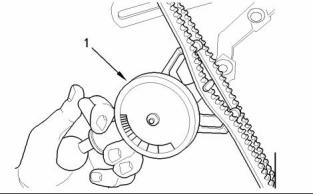
![]()
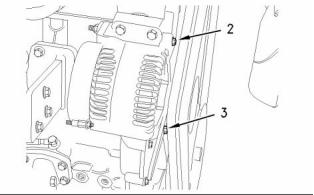
SEBU8352
49
Maintenance Section
Battery - Replace
2. Move the alternator in order to increase or
decrease the belt tension. Tighten the alternator
pivot bolt and the link bolt to 22 N·m (16 lb ft).(1).
5. Remove the used battery.
6. Install the new battery.
Replacement
Note: Before the cables are connected, ensure that
the engine start switch is OFF.
Refer to the Disassembly and Assembly Manual for
the installation procedure and the removal procedure
for the belt.
7. Connect the cable from the starting motor to the
POSITIVE “+” battery terminal.
8. Connect the NEGATIVE “-” cable to the NEGATIVE
“-” battery terminal.
i02322315
Battery - Replace
i02747977
Battery Electrolyte Level -
Check
Batteries give off combustible gases which can
explode. A spark can cause the combustible gas-
es to ignite. This can result in severe personal in-
jury or death.
When the engine is not run for long periods of time or
when the engine is run for short periods, the batteries
may not fully recharge. Ensure a full charge in order
to help prevent the battery from freezing. If batteries
are correctly charged, the ammeter reading should
be very near zero, when the engine is in operation.
Ensure proper ventilation for batteries that are in
an enclosure. Follow the proper procedures in or-
der to help prevent electrical arcs and/or sparks
near batteries. Do not smoke when batteries are
serviced.
All lead-acid batteries contain sulfuric acid which
can burn the skin and clothing. Always wear a face
shield and protective clothing when working on or
near batteries.
The battery cables or the batteries should not be
removed with the battery cover in place. The bat-
tery cover should be removed before any servic-
ing is attempted.
1. Remove the filler caps. Maintain the electrolyte
level to the “FULL” mark on the battery.
Removing the battery cables or the batteries with
the cover in place may cause a battery explosion
resulting in personal injury.
If the addition of water is necessary, use distilled
water. If distilled water is not available use clean
water that is low in minerals. Do not use artificially
softened water.
1. Switch the engine to the OFF position. Remove
all electrical loads.
2. Check the condition of the electrolyte with a
suitable battery tester.
2. Turn off any battery chargers. Disconnect any
battery chargers.
3. Install the caps.
3. The NEGATIVE “-” cable connects the NEGATIVE
“-” battery terminal to the NEGATIVE “-” terminal
on the starting motor. Disconnect the cable from
the NEGATIVE “-” battery terminal.
4. Keep the batteries clean.
Clean the battery case with one of the following
cleaning solutions:
4. The POSITIVE “+” cable connects the POSITIVE
“+” battery terminal to the POSITIVE “+” terminal
on the starting motor. Disconnect the cable from
the POSITIVE “+” battery terminal.
• Use a solution of 0.1 kg (0.2 lb) baking soda
and 1 L (1 qt) of clean water.
• Use a solution of ammonium hydroxide.
Note: Always recycle a battery. Never discard a
battery. Dispose of used batteries to an appropriate
recycling facility.
Thoroughly rinse the battery case with clean water.
This document has been printed from SPI². Not for Resale
![]()
![]()
![]()
![]()
![]()
![]()
![]()
50
SEBU8352
Maintenance Section
Battery or Battery Cable - Disconnect
i02323088
i02203590
Battery or Battery Cable -
Disconnect
Cooling System Coolant
(Commercial Heavy-Duty) -
Change
NOTICE
The battery cables or the batteries should not be
removed with the battery cover in place. The bat-
tery cover should be removed before any servic-
ing is attempted.
Care must be taken to ensure that fluids are contained
during performance of inspection, maintenance, test-
ing, adjusting and repair of the product. Be prepared to
collect the fluid with suitable containers before open-
ing any compartment or disassembling any compo-
nent containing fluids.
Removing the battery cables or the batteries with
the cover in place may cause a battery explosion
resulting in personal injury.
Dispose of all fluids according to Local regulations and
mandates.
1. Turn the start switch to the OFF position. Turn the
ignition switch (if equipped) to the OFF position
and remove the key and all electrical loads.
NOTICE
Keep all parts clean from contaminants.
2. Disconnect the negative battery terminal. Ensure
that the cable cannot contact the terminal. When
four 12 volt batteries are involved, two negative
connection must be disconnected.
Contaminants may cause rapid wear and shortened
component life.
Clean the cooling system and flush the cooling
system before the recommended maintenance
interval if the following conditions exist:
3. Remove the positive connection.
4. Clean all disconnected connection and battery
terminals.
• The engine overheats frequently.
• Foaming is observed.
5. Use a fine grade of sandpaper to clean the
terminals and the cable clamps. Clean the items
until the surfaces are bright or shiny. DO NOT
remove material excessively. Excessive removal
of material can cause the clamps to not fit
correctly. Coat the clamps and the terminals with
a suitable silicone lubricant or petroleum jelly.
•
The oil has entered the cooling system and the
coolant is contaminated.
•
The fuel has entered the cooling system and the
coolant is contaminated.
6. Tape the cable connections in order to help
prevent accidental starting.
Note: When the cooling system is cleaned, only
clean water is needed.
7. Proceed with necessary system repairs.
Note: Inspect the water pump and the water
temperature regulator after the cooling system has
been drained. This is a good opportunity to replace
the water pump, the water temperature regulator and
the hoses, if necessary.
8. In order to connect the battery, connect the
positive connection before the negative connector.
Drain
Pressurized System: Hot coolant can cause seri-
ous burns. To open the cooling system filler cap,
stop the engine and wait until the cooling system
components are cool. Loosen the cooling system
pressure cap slowly in order to relieve the pres-
sure.
This document has been printed from SPI². Not for Resale
![]()
![]()
![]()
![]()
![]()
![]()
![]()
![]()
![]()
SEBU8352
51
Maintenance Section
Cooling System Coolant (Commercial Heavy-Duty) - Change
1. Stop the engine and allow the engine to cool.
Loosen the cooling system filler cap slowly in
order to relieve any pressure. Remove the cooling
system filler cap.
5. Stop the engine and allow the engine to cool.
Loosen the cooling system filler cap slowly in
order to relieve any pressure. Remove the cooling
system filler cap. Open the drain cock or remove
the drain plug on the engine. Open the drain cock
or remove the drain plug on the radiator. Allow
the water to drain. Flush the cooling system with
clean water.
Fill
1. Close the drain cock or install the drain plug on the
engine. Close the drain cock or install the drain
plug on the radiator.
NOTICE
Do not fill the cooling system faster than 5 L
(1.3 US gal) per minute to avoid air locks.
g01003928
Illustration 22
Cooling system air locks may result in engine damage.
2. Open the drain cock or remove the drain plug (1)
on the engine. Open the drain cock or remove the
drain plug on the radiator.
2. Fill the cooling system with Commercial
Heavy-Duty Coolant. Add Supplemental Coolant
Additive to the coolant. For the correct amount,
refer to the Operation and Maintenance Manual,
“Fluid Recommendations” topic (Maintenance
Section) for more information on cooling system
specifications. Do not install the cooling system
filler cap.
Allow the coolant to drain.
NOTICE
Dispose of used engine coolant or recycle. Various
methods have been proposed to reclaim used coolant
for reuse in engine cooling systems. The full distillation
procedure is the only method acceptable by Perkins to
reclaim the coolant.
3. Start and run the engine at low idle. Increase the
engine rpm to high idle. Run the engine at high
idle for one minute in order to purge the air from
the cavities of the engine block. Stop the engine.
For information regarding the disposal and the
recycling of used coolant, consult your Perkins dealer
or your Perkins distributor.
4. Check the coolant level. Maintain the coolant level
within 13 mm (0.5 inch) below the bottom of the
pipe for filling. Maintain the coolant level in the
expansion bottle (if equipped) at the correct level.
Flush
1. Flush the cooling system with clean water in order
to remove any debris.
5. Clean the cooling system filler cap. Inspect the
gasket that is on the cooling system filler cap. If
the gasket that is on the cooling system filler cap
is damaged, discard the old cooling system filler
cap and install a new cooling system filler cap. If
the gasket that is on the cooling system filler cap
is not damaged, use a suitable pressurizing pump
in order to pressure test the cooling system filler
cap. The correct pressure for the cooling system
filler cap is stamped on the face of the cooling
system filler cap. If the cooling system filler cap
does not retain the correct pressure, install a new
cooling system filler cap.
2. Close the drain cock or install the drain plug in the
engine. Close the drain cock or install the drain
plug on the radiator.
NOTICE
Do not fill the cooling system faster than 5 L
(1.3 US gal) per minute to avoid air locks.
Cooling system air locks may result in engine damage.
3. Fill the cooling system with clean water. Install the
cooling system filler cap.
6. Start the engine. Inspect the cooling system for
leaks and for correct operating temperature.
4. Start and run the engine at low idle until the
temperature reaches 49 to 66 °C (120 to 150 °F).
This document has been printed from SPI². Not for Resale
![]()
![]()
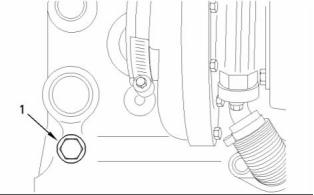
![]()
![]()
![]()
![]()
![]()
![]()
52
SEBU8352
Maintenance Section
Cooling System Coolant (ELC) - Change
i02203595
1. Stop the engine and allow the engine to cool.
Loosen the cooling system filler cap slowly in
order to relieve any pressure. Remove the cooling
system filler cap.
Cooling System Coolant (ELC)
- Change
NOTICE
Care must be taken to ensure that fluids are contained
during performance of inspection, maintenance, test-
ing, adjusting and repair of the product. Be prepared to
collect the fluid with suitable containers before open-
ing any compartment or disassembling any compo-
nent containing fluids.
Dispose of all fluids according to Local regulations and
mandates.
g01003928
Illustration 23
NOTICE
Keep all parts clean from contaminants.
Typical example
2. Open the drain cock or remove the drain plug (1)
on the engine. Open the drain cock or remove the
drain plug on the radiator.
Contaminants may cause rapid wear and shortened
component life.
Clean the cooling system and flush the cooling
system before the recommended maintenance
interval if the following conditions exist:
Allow the coolant to drain.
NOTICE
Dispose of used engine coolant or recycle. Various
methods have been proposed to reclaim used coolant
for reuse in engine cooling systems. The full distillation
procedure is the only method acceptable by Perkins to
reclaim the coolant.
• The engine overheats frequently.
• Foaming is observed.
• The oil has entered the cooling system and the
coolant is contaminated.
For information regarding the disposal and the
recycling of used coolant, consult your Perkins dealer
or your Perkins distributor.
• The fuel has entered the cooling system and the
coolant is contaminated.
Note: When the cooling system is cleaned, only
clean water is needed when the ELC is drained and
replaced.
Flush
1. Flush the cooling system with clean water in order
to remove any debris.
Note: Inspect the water pump and the water
temperature regulator after the cooling system has
been drained. This is a good opportunity to replace
the water pump, the water temperature regulator and
the hoses, if necessary.
2. Close the drain cock or install the drain plug in the
engine. Close the drain cock or install the drain
plug on the radiator.
NOTICE
Do not fill the cooling system faster than 5 L
Drain
(1.3 US gal) per minute to avoid air locks.
Cooling system air locks may result in engine damage.
Pressurized System: Hot coolant can cause seri-
ous burns. To open the cooling system filler cap,
stop the engine and wait until the cooling system
components are cool. Loosen the cooling system
pressure cap slowly in order to relieve the pres-
sure.
3. Fill the cooling system with clean water. Install the
cooling system filler cap.
4. Start and run the engine at low idle until the
temperature reaches 49 to 66 °C (120 to 150 °F).
This document has been printed from SPI². Not for Resale
![]()
![]()
![]()
![]()
![]()
![]()
![]()
![]()
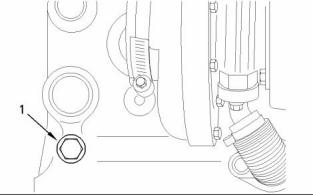
![]()
![]()
![]()
![]()
SEBU8352
53
Maintenance Section
Cooling System Coolant Extender (ELC) - Add
5. Stop the engine and allow the engine to cool.
Loosen the cooling system filler cap slowly in
order to relieve any pressure. Remove the cooling
system filler cap. Open the drain cock or remove
the drain plug on the engine. Open the drain cock
or remove the drain plug on the radiator. Allow
the water to drain. Flush the cooling system with
clean water.
i02335364
Cooling System Coolant
Extender (ELC) - Add
The Perkins Extended Life Coolant (ELC) does not
need the frequent addition of Supplemental Coolant
Additives (SCA) that are associated with conventional
coolants. The Extender only needs to be added once.
Fill
1. Close the drain cock or install the drain plug on the
engine. Close the drain cock or install the drain
plug on the radiator.
Check the cooling system only when the engine is
stopped and cool.
1. Loosen the cooling system filler cap slowly in
order to relieve pressure. Remove the cooling
system filler cap.
NOTICE
Do not fill the cooling system faster than 5 L
(1.3 US gal) per minute to avoid air locks.
2. It may be necessary to drain enough coolant from
the cooling system in order to add the Extender.
Cooling system air locks may result in engine damage.
3. Add Extender according to the requirements for
your engine’s cooling system capacity. Refer to
this Operation and Maintenance Manual, “Refill
Capacities” in the Maintenance Section for the
capacity of the cooling system for your engine.
Refer to this Operation and Maintenance Manual,
“Fluid Recommendations” information for the
Perkins ELC Extender.
2. Fill the cooling system with Extended Life
Coolant (ELC). Refer to the Operation and
Maintenance Manual, “Fluid Recommendations”
topic (Maintenance Section) for more information
on cooling system specifications. Do not install the
cooling system filler cap.
3. Start and run the engine at low idle. Increase the
engine rpm to high idle. Run the engine at high
idle for one minute in order to purge the air from
the cavities of the engine block. Stop the engine.
4. Clean the cooli, ng system filler cap and inspect the
gasket. If the gasket is damaged, discard the old
filler cap and install a new filler cap. If the gasket
is not damaged, use a suitable pressurizing pump
in order to pressure test the filler cap. The correct
pressure is stamped on the face of the filler cap. If
the filler cap does not retain the correct pressure,
install a new filler cap.
4. Check the coolant level. Maintain the coolant level
within 13 mm (0.5 inch) below the bottom of the
pipe for filling. Maintain the coolant level in the
expansion bottle (if equipped) at the correct level.
5. Clean the cooling system filler cap. Inspect the
gasket that is on the cooling system filler cap. If
the gasket that is on the cooling system filler cap
is damaged, discard the old cooling system filler
cap and install a new cooling system filler cap. If
the gasket that is on the cooling system filler cap
is not damaged, use a suitable pressurizing pump
in order to pressure test the cooling system filler
cap. The correct pressure for the cooling system
filler cap is stamped on the face of the cooling
system filler cap. If the cooling system filler cap
does not retain the correct pressure, install a new
cooling system filler cap.
i02335378
Cooling System Coolant Level
- Check
Engines With a Coolant Recovery
Tank
Note: The cooling system may not have been
provided by Perkins. The procedure that follows
is for typical cooling systems. Refer to the OEM
information for the correct procedures.
6. Start the engine. Inspect the cooling system for
leaks and for correct operating temperature.
Check the coolant level when the engine is stopped
and cool.
This document has been printed from SPI². Not for Resale
![]()
![]()
![]()
54
SEBU8352
Maintenance Section
Driven Equipment - Check
1. Observe the coolant level in the coolant recovery
tank. Maintain the coolant level to “COLD FULL”
mark on the coolant recovery tank.
Pressurized System: Hot coolant can cause seri-
ous burns. To open the cooling system filler cap,
stop the engine and wait until the cooling system
components are cool. Loosen the cooling system
pressure cap slowly in order to relieve the pres-
sure.
2. Loosen filler cap slowly in order to relieve any
pressure. Remove the filler cap.
g00285520
Illustration 25
Cooling system filler cap
3. Pour the correct coolant mixture into the tank.
Refer to the Operation and Maintenance Manual,
“Refill Capacities and Recommendations” for
information on the correct mixture and type of
coolant. Refer to the Operation and Maintenance
Manual, “Refill Capacities and Recommendations”
for the cooling system capacity. Do not fill the
coolant recovery tank above “COLD FULL” mark.
Pressurized System: Hot coolant can cause seri-
ous burns. To open the cooling system filler cap,
stop the engine and wait until the cooling system
components are cool. Loosen the cooling system
pressure cap slowly in order to relieve the pres-
sure.
1. Remove the cooling system filler cap slowly in
order to relieve pressure.
2. Maintain the coolant level within 13 mm (0.5 inch)
of the bottom of the filler pipe. If the engine is
equipped with a sight glass, maintain the coolant
level to the correct level in the sight glass.
3. Clean the cooling system filler cap and inspect the
gasket. If the gasket is damaged, discard the old
filler cap and install a new filler cap. If the gasket
is not damaged, use a suitable pressurizing pump
in order to pressure test the filler cap. The correct
pressure is stamped on the face of the filler cap. If
the filler cap does not retain the correct pressure,
install a new filler cap.
g00103639
Illustration 24
4. Clean filler cap and the receptacle. Reinstall the
filler cap and inspect the cooling system for leaks.
Note: The coolant will expand as the coolant heats
up during normal engine operation. The additional
volume will be forced into the coolant recovery tank
during engine operation. When the engine is stopped
and cool, the coolant will return to the engine.
4. Inspect the cooling system for leaks.
i00174798
Driven Equipment - Check
Engines Without a Coolant
Recovery Tank
Refer to the OEM specifications for more information
on the following maintenance recommendations for
the driven equipment:
Check the coolant level when the engine is stopped
and cool.
• Inspection
• Adjustment
This document has been printed from SPI². Not for Resale
![]()
![]()
![]()
![]()
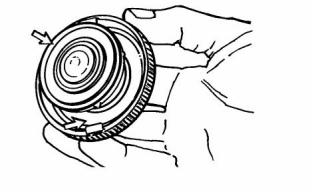
![]()
![]()
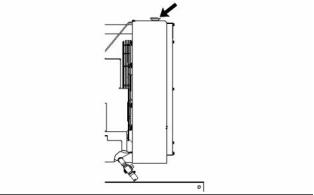
![]()
![]()
SEBU8352
55
Maintenance Section
Engine - Clean
• Lubrication
i01915869
Engine Air Cleaner Element
(Dual Element) - Clean/Replace
• Other maintenance recommendations
Perform any maintenance for the driven equipment
which is recommended by the OEM.
NOTICE
i01930350
Never run the engine without an air cleaner element
installed. Never run the engine with a damaged air
cleaner element. Do not use air cleaner elements with
damaged pleats, gaskets or seals. Dirt entering the
engine causes premature wear and damage to engine
components. Air cleaner elements help to prevent air-
borne debris from entering the air inlet.
Engine - Clean
Personal injury or death can result from high volt-
age.
NOTICE
Never service the air cleaner element with the engine
running since this will allow dirt to enter the engine.
Moisture can create paths of electrical conductiv-
ity.
Make sure that the electrical system is OFF. Lock
out the starting controls and tag the controls “DO
NOT OPERATE”.
Servicing the Air Cleaner Elements
Note: The air filter system may not have been
provided by Perkins. The procedure that follows
is for a typical air filter system. Refer to the OEM
information for the correct procedure.
NOTICE
Accumulated grease and oil on an engine is a fire haz-
ard. Keep the engine clean. Remove debris and fluid
spills whenever a significant quantity accumulates on
the engine.
If the air cleaner element becomes plugged, the air
can split the material of the air cleaner element.
Unfiltered air will drastically accelerate internal
engine wear. Refer to the OEM information for the
correct air cleaner elements for your application.
NOTICE
Failure to protect some engine components from
washing may make your engine warranty invalid.
Allow the engine to cool for one hour before washing
the engine.
• Check the precleaner (if equipped) and the dust
bowl daily for accumulation of dirt and debris.
Remove any dirt and debris, as needed.
• Operating conditions (dust, dirt and debris) may
require more frequent service of the air cleaner
element.
Periodic cleaning of the engine is recommended.
Steam cleaning the engine will remove accumulated
oil and grease. A clean engine provides the following
benefits:
• The air cleaner element should be replaced at least
one time per year. This replacement should be
performed regardless of the number of cleanings.
• Easy detection of fluid leaks
• Maximum heat transfer characteristics
• Ease of maintenance
Replace the dirty air cleaner elements with clean air
cleaner elements. Before installation, the air cleaner
elements should be thoroughly checked for tears
and/or holes in the filter material. Inspect the gasket
or the seal of the air cleaner element for damage.
Maintain a supply of suitable air cleaner elements
for replacement purposes.
Note: Caution must be used in order to prevent
electrical components from being damaged by
excessive water when the engine is cleaned.
Pressure washers and steam cleaners should not be
directed at any electrical connectors or the junction of
cables into the rear of the connectors. Avoid electrical
components such as the alternator and the starter.
Protect the fuel injection pump from fluids in order
to wash the engine.
This document has been printed from SPI². Not for Resale
![]()
![]()
![]()
![]()
![]()
![]()
![]()
![]()
![]()
![]()
![]()
56
SEBU8352
Maintenance Section
Engine Air Cleaner Element (Dual Element) - Clean/Replace
Cleaning the Primary Air Cleaner
Dual Element Air Cleaners
Elements
The dual element air cleaner contains a primary air
cleaner element and a secondary air cleaner element.
The primary air cleaner element can be used up
to six times if the element is properly cleaned and
properly inspected. The primary air cleaner element
should be replaced at least one time per year. This
replacement should be performed regardless of the
number of cleanings.
NOTICE
Observe the following guidelines if you attempt to
clean the filter element:
Do not tap or strike the filter element in order to re-
move dust.
Do not wash the filter element.
The secondary air cleaner element is not serviceable
or washable. Refer to the OEM information for
instructions in order to replace the secondary air
cleaner element. When the engine is operating in
environments that are dusty or dirty, air cleaner
elements may require more frequent replacement.
Use low pressure compressed air in order to remove
the dust from the filter element. Air pressure must not
exceed 207 kPa (30 psi). Direct the air flow up the
pleats and down the pleats from the inside of the filter
element. Take extreme care in order to avoid damage
to the pleats.
Do not use air filters with damaged pleats, gaskets, or
seals. Dirt entering the engine will cause damage to
engine components.
Refer to the OEM information in order to determine
the number of times that the primary filter element can
be cleaned. When the primary air cleaner element is
cleaned, check for rips or tears in the filter material.
The primary air cleaner element should be replaced
at least one time per year. This replacement should
be performed regardless of the number of cleanings.
g00736431
Illustration 26
NOTICE
(1) Cover
Do not clean the air cleaner elements by bumping or
tapping. This could damage the seals. Do not use el-
ements with damaged pleats, gaskets or seals. Dam-
aged elements will allow dirt to pass through. Engine
damage could result.
(2) Primary air cleaner element
(3) Secondary air cleaner element
(4) Air inlet
1. Remove the cover. Remove the primary air
cleaner element.
Visually inspect the primary air cleaner elements
before cleaning. Inspect the air cleaner elements for
damage to the seal, the gaskets, and the outer cover.
Discard any damaged air cleaner elements.
2. The secondary air cleaner element should be
removed and discarded for every three cleanings
of the primary air cleaner element.
Note: Refer to “Cleaning the Primary Air Cleaner
Elements”.
There are two common methods that are used to
clean primary air cleaner elements:
3. Cover the air inlet with tape in order to keep dirt
out.
• Pressurized air
• Vacuum cleaning
4. Clean the inside of the air cleaner cover and body
with a clean, dry cloth.
Pressurized Air
5. Remove the tape for the air inlet. Install the
secondary air cleaner element. Install a primary
air cleaner element that is new or cleaned.
Pressurized air can be used to clean primary air
cleaner elements that have not been cleaned more
than two times. Pressurized air will not remove
deposits of carbon and oil. Use filtered, dry air with a
maximum pressure of 207 kPa (30 psi).
6. Install the air cleaner cover.
7. Reset the air cleaner service indicator.
This document has been printed from SPI². Not for Resale
![]()
![]()
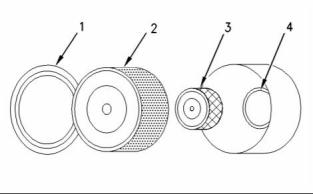
![]()
![]()
![]()
![]()
SEBU8352
57
Maintenance Section
Engine Air Cleaner Element (Single Element) - Inspect/Replace
Inspect the clean, dry primary air cleaner element.
Use a 60 watt blue light in a dark room or in a similar
facility. Place the blue light in the primary air cleaner
element. Rotate the primary air cleaner element.
Inspect the primary air cleaner element for tears
and/or holes. Inspect the primary air cleaner element
for light that may show through the filter material. If it
is necessary in order to confirm the result, compare
the primary air cleaner element to a new primary air
cleaner element that has the same part number.
Do not use a primary air cleaner element that has
any tears and/or holes in the filter material. Do not
use a primary air cleaner element with damaged
pleats, gaskets or seals. Discard damaged primary
g00281692
Illustration 27
air cleaner elements.
Note: When the primary air cleaner elements are
cleaned, always begin with the clean side (inside)
in order to force dirt particles toward the dirty side
(outside).
i02152042
Engine Air Cleaner
Element (Single Element) -
Inspect/Replace
Aim the hose so that the air flows inside the element
along the length of the filter in order to help prevent
damage to the paper pleats. Do not aim the stream
of air directly at the primary air cleaner element. Dirt
could be forced further into the pleats.
Refer to Operation and Maintenance Manual, “Engine
Air Cleaner Service Indicator-Inspect”.
Note: Refer to “Inspecting the Primary Air Cleaner
Elements”.
NOTICE
Vacuum Cleaning
Never run the engine without an air cleaner element
installed. Never run the engine with a damaged air
cleaner element. Do not use air cleaner elements with
damaged pleats, gaskets or seals. Dirt entering the
engine causes premature wear and damage to engine
components. Air cleaner elements help to prevent air-
borne debris from entering the air inlet.
Vacuum cleaning is a good method for cleaning
primary air cleaner elements which require daily
cleaning because of a dry, dusty environment.
Cleaning with pressurized air is recommended prior
to vacuum cleaning. Vacuum cleaning will not remove
deposits of carbon and oil.
NOTICE
Never service the air cleaner element with the engine
running since this will allow dirt to enter the engine.
Note: Refer to “Inspecting the Primary Air Cleaner
Elements”.
Inspecting the Primary Air Cleaner
Elements
A wide variety of air cleaners may be installed for use
with this engine. Consult the OEM information for the
correct procedure to replace the air cleaner.
i01909507
Engine Air Cleaner Service
Indicator - Inspect
Some engines may be equipped with a different
service indicator.
g00281693
Illustration 28
This document has been printed from SPI². Not for Resale
![]()
![]()
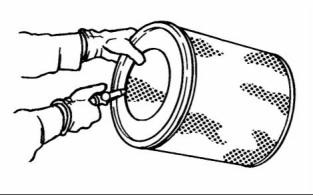
![]()
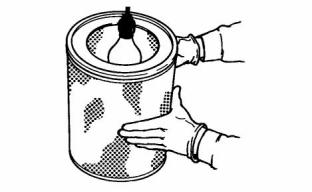
![]()
![]()
![]()
![]()
![]()
58
SEBU8352
Maintenance Section
Engine Mounts - Inspect
Some engines are equipped with a differential gauge
for inlet air pressure. The differential gauge for inlet
air pressure displays the difference in the pressure
that is measured before the air cleaner element and
the pressure that is measured after the air cleaner
element. As the air cleaner element becomes dirty,
the pressure differential rises. If your engine is
equipped with a different type of service indicator,
follow the OEM recommendations in order to service
the air cleaner service indicator.
i02323089
Engine Mounts - Inspect
Note: The engine mounts may not have been
supplied by Perkins. Refer to the OEM information
for further information on the engine mounts and the
correct bolt torque.
Inspect the engine mounts for deterioration and for
correct bolt torque. Engine vibration can be caused
by the following conditions:
The service indicator may be mounted on the air
cleaner element or in a remote location.
• Incorrect mounting of the engine
• Deterioration of the engine mounts
• Loose engine mounts
Any engine mount that shows deterioration should
be replaced. Refer to the OEM information for the
recommended torques.
i02676018
Engine Oil Level - Check
g00103777
Illustration 29
Typical service indicator
Observe the service indicator. The air cleaner
element should be cleaned or the air cleaner element
should be replaced when one of the following
conditions occur:
Hot oil and hot components can cause personal
injury. Do not allow hot oil or hot components to
contact the skin.
• The yellow diaphragm enters the red zone.
• The red piston locks in the visible position.
Test the Service Indicator
Service indicators are important instruments.
• Check for ease of resetting. The service indicator
should reset in less than three pushes.
• Check the movement of the yellow core when the
engine is accelerated to the engine rated speed.
The yellow core should latch approximately at the
greatest vacuum that is attained.
g01165836
Illustration 30
If the service indicator does not reset easily, or if the
yellow core does not latch at the greatest vacuum,
the service indicator should be replaced. If the new
service indicator will not reset, the hole for the service
indicator may be restricted.
(Y) “MIN” mark. (X) “MAX” mark.
NOTICE
Perform this maintenance with the engine stopped.
The service indicator may need to be replaced
frequently in environments that are severely dusty.
Note: Ensure that the engine is either level or that
the engine is in the normal operating position in order
to obtain a true level indication.
This document has been printed from SPI². Not for Resale
![]()
![]()
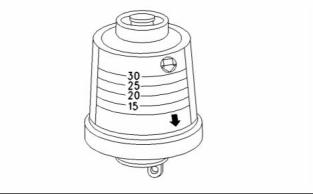
![]()
![]()
![]()
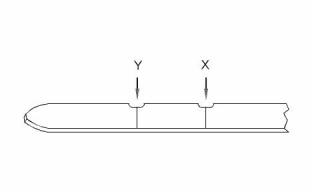
![]()
![]()
![]()
SEBU8352
59
Maintenance Section
Engine Oil Sample - Obtain
Note: After the engine has been switched OFF, allow
the engine oil to drain to the oil pan before checking
the oil level.
• Engine number
• Service hours on the engine
1. Maintain the oil level between the “MIN” mark (Y)
and the “MAX” mark (X) on the engine oil dipstick.
Do not fill the crankcase above the “MAX” mark
(X).
• The number of hours that have accumulated since
the last oil change
• The amount of oil that has been added since the
last oil change
NOTICE
Ensure that the container for the sample is clean and
dry. Also ensure that the container for the sample is
clearly labelled.
Operating your engine when the oil level is above the
“FULL” mark could cause your crankshaft to dip into
the oil. The air bubbles created from the crankshaft
dipping into the oil reduces the oil’s lubricating char-
acteristics and could result in the loss of power.
To ensure that the sample is representative of the
oil in the crankcase, obtain a warm, well mixed oil
sample.
2. Remove the oil filler cap and add oil, if necessary.
Clean the oil filler cap. Install the oil filler cap.
To avoid contamination of the oil samples, the tools
and the supplies that are used for obtaining oil
samples must be clean.
i02202699
Engine Oil Sample - Obtain
The sample can be checked for the following: the
quality of the oil, the existence of any coolant in the
oil, the existence of any ferrous metal particles in
the oil, and the existence of any nonferrous metal
particles in the oil.
The condition of the engine lubricating oil may be
checked at regular intervals as part of a preventive
maintenance program. Perkins include an oil
sampling valve as an option. The oil sampling valve
(if equipped) is included in order to regularly sample
the engine lubricating oil. The oil sampling valve is
positioned on the oil filter head or the oil sampling
valve is positioned on the cylinder block.
i02703306
Engine Oil and Filter - Change
Perkins recommends using a sampling valve in order
to obtain oil samples. The quality and the consistency
of the samples are better when a sampling valve is
used. The location of the sampling valve allows oil
that is flowing under pressure to be obtained during
normal engine operation.
Hot oil and hot components can cause personal
injury. Do not allow hot oil or hot components to
contact the skin.
Do not drain the oil when the engine is cold. As the oil
cools, suspended waste particles settle on the bottom
of the oil pan. The waste particles are not removed
with the draining cold oil. Drain the crankcase with
the engine stopped. Drain the crankcase with the
oil warm. This draining method allows the waste
particles that are suspended in the oil to be drained
properly.
Obtain the Sample and the Analysis
Hot oil and hot components can cause personal
injury. Do not allow hot oil or hot components to
contact the skin.
Failure to follow this recommended procedure will
cause the waste particles to be recirculated through
the engine lubrication system with the new oil.
In order to help obtain the most accurate analysis,
record the following information before an oil sample
is taken:
• The date of the sample
• Engine model
This document has been printed from SPI². Not for Resale
![]()
![]()
![]()
![]()
![]()
![]()
![]()
60
SEBU8352
Maintenance Section
Engine Oil and Filter - Change
Drain the Engine Oil
1. Remove the oil filter with a suitable tool.
Note: The following actions can be carried out as
part of the preventive maintenance program.
2. Cut the oil filter open with a suitable tool. Break
apart the pleats and inspect the oil filter for metal
debris. An excessive amount of metal debris in
the oil filter may indicate early wear or a pending
failure.
Use a magnet to differentiate between the ferrous
metals and the nonferrous metals that are found in
the oil filter element. Ferrous metals may indicate
wear on the steel and cast iron parts of the engine.
Nonferrous metals may indicate wear on the
aluminum parts, brass parts or bronze parts of
the engine. Parts that may be affected include
the following items: main bearings, rod bearings,
turbocharger bearings, and cylinder heads.
Due to normal wear and friction, it is not
uncommon to find small amounts of debris in the
oil filter.
g01356033
Illustration 31
Oil drain plug
After the engine has been run at the normal operating
temperature, stop the engine. Use one of the
following methods to drain the engine crankcase oil:
• If the engine is equipped with a drain valve, turn the
drain valve knob counterclockwise in order to drain
the oil. After the oil has drained, turn the drain valve
knob clockwise in order to close the drain valve.
• If the engine is not equipped with a drain valve,
remove the oil drain plug (1) in order to allow the
oil to drain. If the engine is equipped with a shallow
sump, remove the bottom oil drain plugs from both
ends of the oil pan.
After the oil has drained, the oil drain plugs should
be cleaned and installed. If necessary, renew the O
ring seal on the drain plug.
Some types of oil pans have oil drain plugs that are
on both sides of the oil pan, because of the shape of
the pan. This type of oil pan requires the engine oil to
be drained from both plugs.
g01356034
Illustration 32
(2) Filter head
(3) O ring seal
Replace the Spin-on Oil Filter
3. Clean the sealing surface of the oil filter head (2).
Ensure that the union (4) in the oil filter head is
secure.
NOTICE
Perkins oil filters are manufactured to Perkins speci-
fications. Use of an oil filter that is not recommended
by Perkins could result in severe damage to the en-
gine bearings, crankshaft, etc., as a result of the larger
waste particles from unfiltered oil entering the engine
lubricating system. Only use oil filters recommended
by Perkins.
4. Apply clean engine oil to the O ring seal (3) on
the oil filter.
This document has been printed from SPI². Not for Resale
![]()
![]()
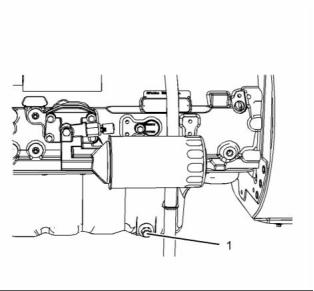
![]()
![]()
![]()
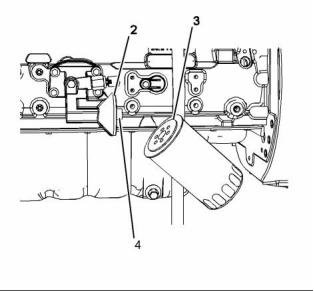
SEBU8352
61
Maintenance Section
Engine Valve Lash - Inspect/Adjust
2. Start the engine and run the engine at “LOW
IDLE” for two minutes. Perform this procedure in
order to ensure that the lubrication system has
oil and that the oil filters are filled. Inspect the oil
filter for oil leaks.
NOTICE
Do not fill the oil filters with oil before installing them.
This oil would not be filtered and could be contaminat-
ed. Contaminated oil can cause accelerated wear to
engine components.
3. Stop the engine and allow the oil to drain back to
the sump for a minimum of ten minutes.
5. Install the oil filter. Tighten the oil filter by hand
according to the instructions that are shown on
the oil filter. Do not overtighten the oil filter.
Note: Some oil filters may be installed vertically.
Refer to illustration 33. Start at step (1) in order to
remove the oil filter and install the oil filter.
g01165836
Illustration 34
(Y) “MIN” mark. (X) “MAX” mark.
4. Remove the oil level gauge in order to check the
oil level. Maintain the oil level between the “MIN”
and “MAX” marks on the engine oil dipstick.
i02171102
Engine Valve Lash -
Inspect/Adjust
g01356074
Illustration 33
Typical example
This maintenance is recommended by Perkins as
part of a lubrication and preventive maintenance
schedule in order to help provide maximum engine
life.
Fill the Engine Crankcase
1. Remove the oil filler cap. Refer to the Operation
and Maintenance Manual for more information on
lubricant specifications. Fill the crankcase with the
proper amount of oil. Refer to the Operation and
Maintenance Manual for more information on refill
capacities.
NOTICE
Only qualified service personel should perform this
maintenance. Refer to the Service Manual or your au-
thorized Perkins dealer or your Perkins distributor for
the complete valve lash adjustment procedure.
NOTICE
Operation of Perkins engines with incorrect valve lash
can reduce engine efficiency, and also reduce engine
component life.
If equipped with an auxiliary oil filter system or a re-
mote oil filter system, follow the OEM or filter manu-
facturer’s recommendations. Under filling or overfilling
the crankcase with oil can cause engine damage.
NOTICE
To prevent crankshaft bearing damage, crank the en-
gine with the fuel OFF. This will fill the oil filters before
starting the engine. Do not crank the engine for more
than 30 seconds.
This document has been printed from SPI². Not for Resale
![]()
![]()
![]()
![]()
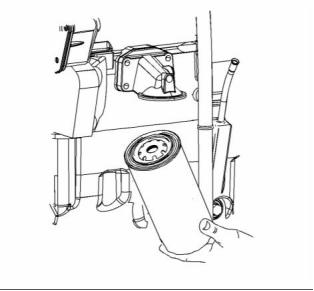
![]()
![]()
![]()
![]()
![]()
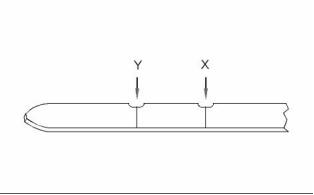
![]()
![]()
62
SEBU8352
Maintenance Section
Fuel Injector - Test/Change
Ensure that the engine can not be started while
this maintenance is being performed. To help pre-
vent possible injury, do not use the starting motor
to turn the flywheel.
Hot engine components can cause burns. Allow
additional time for the engine to cool before mea-
suring/adjusting valve lash clearance.
Ensure that the engine is stopped before measuring
the valve lash. The engine valve lash can be
inspected and adjusted when the temperature of the
engine is hot or cold.
Refer to Systems Operation/Testing and Adjusting,
“Engine Valve Lash - Inspect/Adjust” for more
information.
i02198352
Fuel Injector - Test/Change
g01110422
Illustration 35
Typical fuel Injectors
Fuel leaked or spilled onto hot surfaces or electri-
cal components can cause a fire.
The fuel injector (1) will need to be removed and the
injector will need to be checked for performance.
NOTICE
The fuel injectors should not be cleaned as cleaning
with incorrect tools can damage the nozzle. The fuel
injectors should be renewed only if a fault with the
fuel injectors occurs. Some of the problems that may
indicate that new fuel injectors are needed are listed
below:
Do not allow dirt to enter the fuel system. Thoroughly
clean the area around a fuel system component that
will be disconnected. Fit a suitable cover over discon-
nected fuel system component.
NOTICE
• The engine will not start or the engine is difficult
If a fuel injector is suspected of operating outside of
normal parameters it should be removed by a qualified
technician. The suspect fuel injector should be taken
to an authorised agent for inspection.
to start.
• Not enough power
• The engine misfires or the engine runs erratically.
• High fuel consumption
The fuel injector (1) in illustration 35 has no fuel
return. The fuel injector (2) has a fuel return.
• Black exhaust smoke
• The engine knocks or there is vibration in the
engine.
• Excessive engine temperature
This document has been printed from SPI². Not for Resale
![]()
![]()
![]()
![]()
![]()
![]()
![]()
![]()
![]()
![]()
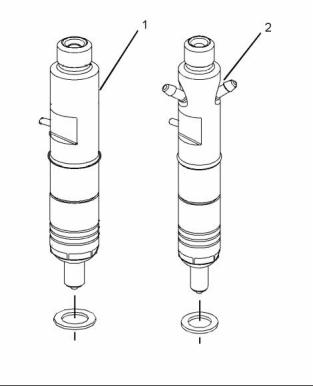
SEBU8352
63
Maintenance Section
Fuel System - Prime
Removal and Installation of the
Fuel Injectors
Use the following procedure in order to remove air
from the fuel system:
1. Ensure that all fuel connections are installed
correctly.
2. Turn the keyswitch to the RUN position. Leave the
keyswitch in the RUN position for three minutes.
If a manual purging screw is installed, slacken
the manual purging screw during priming the fuel
system.
Work carefully around an engine that is running.
Engine parts that are hot, or parts that are moving,
can cause personal injury.
3. Crank the engine with the throttle lever in the
Make sure that you wear eye protection at all
times during testing. When fuel injection nozzles
are tested, test fluids travel through the orifices
of the nozzle tip with high pressure. Under this
amount of pressure, the test fluid can pierce the
skin and cause serious injury to the operator.
Always keep the tip of the fuel injection nozzle
pointed away from the operator and into the fuel
collector and extension.
closed position until the engine starts.
NOTICE
If your skin comes into contact with high pressure fuel,
obtain medical assistence immediately.
Operate the engine at a fast idle speed in order to
identify the faulty fuel injector. Individually loosen and
tighten the union nut for the high pressure pipe to
each fuel injector. Do not loosen the union nut more
than half a turn. There will be little effect on the engine
speed when the union nut to the faulty fuel injection
nozzle is loosened. Refer to the Disassembly and
Assembly Manual for more information. Consult your
authorized Perkins dealer or your Perkins distributor
for assistance.
g01228000
Illustration 36
Injector nuts
Note: If necessary, loosen the union nuts (1) on the
fuel injection lines at the connection with the fuel
injector until fuel is evident. Stop cranking the engine.
Tighten the union nuts to a torque of 27 N·m (20 lb ft).
4. Start the engine and run the engine at idle for one
minute.
i02869449
5. Cycle the throttle lever from the low idle position to
the high idle position three times. The cycle time
for the throttle lever is approximately one second
to six seconds for one complete cycle.
Fuel System - Prime
Note: In order to purge air from the fuel injection
pump on Perkins engines with a fixed throttle, the
engine should be run at full load for thirty seconds.
This should be repeated three times. This will assist
in removing trapped air from the fuel injection pump.
If air enters the fuel system, the air must be purged
from the fuel system before the engine can be
started. Air can enter the fuel system when the
following events occur:
• The fuel tank is empty or the fuel tank has been
partially drained.
6. Return the engine to no load condition. Check for
leaks in the fuel system.
• The low pressure fuel lines are disconnected.
• A leak exists in the low pressure fuel system.
• The fuel filter is replaced.
• A new injection pump is installed.
This document has been printed from SPI². Not for Resale
![]()
![]()
![]()
![]()
![]()
![]()
![]()
![]()
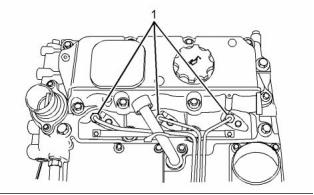
64
SEBU8352
Maintenance Section
Fuel System Primary Filter/Water Separator - Drain
i02873783
Fuel System Primary
Filter/Water Separator - Drain
Fuel leaked or spilled onto hot surfaces or elec-
trical components can cause a fire. To help pre-
vent possible injury, turn the start switch off when
changing fuel filters or water separator elements.
Clean up fuel spills immediately.
NOTICE
The water separator is not a filter. The water separa-
tor separates water from the fuel. The engine should
never be allowed to run with the water separator more
than half full. Engine damage may result.
NOTICE
The water separator is under suction during normal
engine operation. Ensure that the drain valve is tight-
ened securely to help prevent air from entering the fuel
system.
g01118416
Illustration 37
(1) Screw
(2) Element
(3) Glass bowl
(4) Sensor connection
(5) Drain
(6) Bottom cover
1. Place a suitable container below the water
separator.
2. Open the drain (5). Allow the fluid to drain into
the container.
3. When clean fuel drains from the water separator
close the drain (5). Tighten the drain by hand
pressure only. Dispose of the drained fluid
correctly.
This document has been printed from SPI². Not for Resale
![]()
![]()
![]()
![]()
![]()
![]()
![]()
![]()
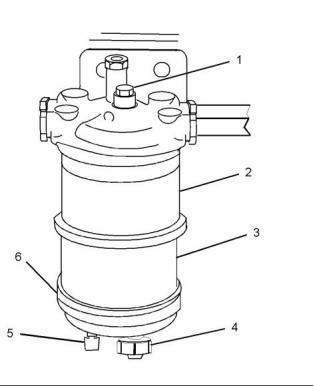
SEBU8352
65
Maintenance Section
Fuel System Primary Filter (Water Separator) Element - Replace
i02875191
1. Turn the fuel supply valve (if equipped) to the OFF
position.
Fuel System Primary Filter
(Water Separator) Element -
Replace
2. Place a suitable container under the water
separator. Clean the outside of the water
separator.
3. Open the drain (5). Allow the fluid to drain into
the container.
4. Tighten the drain (5) by hand pressure only.
Fuel leaked or spilled onto hot surfaces or elec-
trical components can cause a fire. To help pre-
vent possible injury, turn the start switch off when
changing fuel filters or water separator elements.
Clean up fuel spills immediately.
5. Hold the element (2) and remove the screw (1).
Remove the element and the glass bowl (3) from
the base. Discard the old element.
6. Clean the glass bowl (4). Clean the bottom cover
(6).
NOTICE
Do not allow dirt to enter the fuel system. Thoroughly
clean the area around a fuel system component that
will be disconnected. Fit a suitable cover over discon-
nected fuel system component.
7. Install the new O ring seal. Install the bottom cover
onto the new element. Install the assembly onto
the base.
8. Install the screw (1) and tighten the screw to a
torque of 8 N·m (6 lb ft).
9. Remove the container and dispose of the fuel
safely.
10. Open the fuel supply valve.
11. Prime the fuel system. Refer to the Operation and
Maintenance Manual, “Fuel System - Prime” for
more information.
i02873572
Fuel System Secondary Filter -
Replace
Fuel leaked or spilled onto hot surfaces or elec-
trical components can cause a fire. To help pre-
vent possible injury, turn the start switch off when
changing fuel filters or water separator elements.
Clean up fuel spills immediately.
g01118416
Illustration 38
NOTICE
Typical example
Do not allow dirt to enter the fuel system. Thoroughly
clean the area around a fuel system component that
will be disconnected. Fit a suitable cover over discon-
nected fuel system component.
(1) Screw
(2) Element
(3) Glass bowl
(4) Sensor connection
(5) Drain
(6) Bottom cover
This document has been printed from SPI². Not for Resale
![]()
![]()
![]()
![]()
![]()
![]()
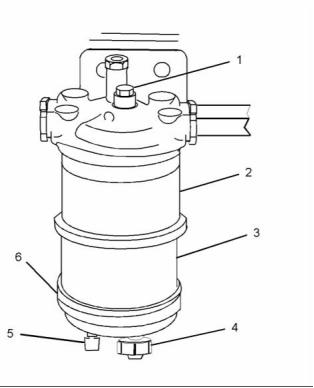
![]()
![]()
![]()
![]()
66
SEBU8352
Maintenance Section
Hoses and Clamps - Inspect/Replace
Spin-on filter
Turn the valves for the fuel lines (if equipped) to the
OFF position before performing this maintenance.
Place a tray under the fuel filter in order to catch
any fuel that might spill. Clean up any spilled fuel
immediately.
g01440510
Illustration 40
Typical example
4. Lubricate the sealing ring (4) with clean fuel oil.
5. Install the spin-on filter (2) into the top of the fuel
priming pump (1).
6. Tighten the spin-on filter by hand until the sealing
ring contacts the fuel priming pump. Rotate the
spin-on filter through 90 degrees.
7. Prime the fuel system. Refer to Operation and
Maintenance Manual, “Fuel System - Prime”.
g01440509
Illustration 39
Typical example
i02813964
Hoses and Clamps -
Inspect/Replace
(1) Fuel priming pump
(2) Spin-on filter
(3) Drain
1. Clean the outside of the fuel filter assembly. Open
the fuel drain (3) and drain the fuel into a suitable
container.
Inspect all hoses for leaks that are caused by the
following conditions:
2. Use a suitable tool in order to remove the spin-on
filter (2) from the fuel priming pump (1).
• Cracking
3. Ensure that the fuel drain (3) on the new spin-on
filter is closed.
• Softness
• Loose clamps
Replace hoses that are cracked or soft. Tighten any
loose clamps.
This document has been printed from SPI². Not for Resale
![]()
![]()
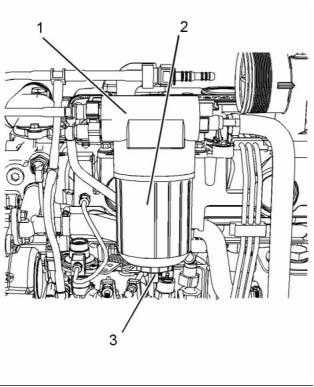
![]()
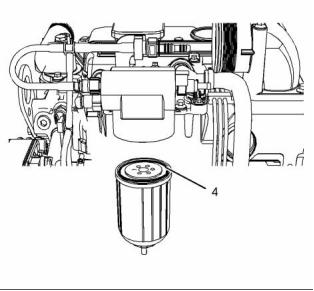
SEBU8352
67
Maintenance Section
Radiator - Clean
NOTICE
Do not bend or strike high pressure lines. Do not in-
stall bent or damaged lines, tubes or hoses. Repair
any loose or damaged fuel and oil lines, tubes and
hoses. Leaks can cause fires. Inspect all lines, tubes
and hoses carefully. Tighten all connections to the rec-
ommended torque. Do not clip any other item to the
high pressure lines.
Pressurized System: Hot coolant can cause seri-
ous burns. To open the cooling system filler cap,
stop the engine and wait until the cooling system
components are cool. Loosen the cooling system
pressure cap slowly in order to relieve the pres-
sure.
1. Stop the engine. Allow the engine to cool.
Check for the following conditions:
2. Loosen the cooling system filler cap slowly in
order to relieve any pressure. Remove the cooling
system filler cap.
• End fittings that are damaged or leaking
• Outer covering that is chafed or cut
Note: Drain the coolant into a suitable, clean
container. The coolant can be reused.
• Exposed wire that is used for reinforcement
• Outer covering that is ballooning locally
• Flexible part of the hose that is kinked or crushed
• Armoring that is embedded in the outer covering
3. Drain the coolant from the cooling system to a
level that is below the hose that is being replaced.
4. Remove the hose clamps.
5. Disconnect the old hose.
A constant torque hose clamp can be used in place
of any standard hose clamp. Ensure that the constant
torque hose clamp is the same size as the standard
clamp.
6. Replace the old hose with a new hose.
7. Install the hose clamps with a torque wrench.
Due to extreme temperature changes, the hose will
harden. Hardening of the hoses will cause hose
clamps to loosen. This can result in leaks. A constant
torque hose clamp will help to prevent loose hose
clamps.
Note: For the correct coolant, see this Operation and
Maintenance Manual, “Fluid Recommendations”.
8. Refill the cooling system. Refer to the OEM
information for further information on refilling the
cooling system.
Each installation application can be different. The
differences depend on the following factors:
9. Clean the cooling system filler cap. Inspect the
cooling system filler cap’s seals. Replace the
cooling system filler cap if the seals are damaged.
Install the cooling system filler cap.
• Type of hose
• Type of fitting material
10. Start the engine. Inspect the cooling system for
leaks.
• Anticipated expansion and contraction of the hose
• Anticipated expansion and contraction of the
fittings
i02335774
Radiator - Clean
Replace the Hoses and the Clamps
Refer to the OEM information for further information
on removing and replacing fuel hoses (if equipped).
The radiator is not usually supplied by Perkins. The
following text describes a typical cleaning procedure
for the radiator. Refer to the OEM information for
further information on cleaning the radiator.
The coolant system and the hoses for the coolant
system are not usually supplied by Perkins. The
following text describes a typical method of replacing
coolant hoses. Refer to the OEM information for
further information on the coolant system and the
hoses for the coolant system.
Note: Adjust the frequency of cleaning according to
the effects of the operating environment.
This document has been printed from SPI². Not for Resale
![]()
![]()
![]()
![]()
![]()
68
SEBU8352
Maintenance Section
Severe Service Application - Check
Inspect the radiator for these items: Damaged fins,
corrosion, dirt, grease, insects, leaves, oil, and other
debris. Clean the radiator, if necessary.
i02335775
Severe Service Application -
Check
Personal injury can result from air pressure.
Severe service is the application of an engine that
exceeds the current published standards for that
engine. Perkins maintains standards for the following
engine parameters:
Personal injury can result without following prop-
er procedure. When using pressure air, wear a pro-
tective face shield and protective clothing.
• Performance such as power range, speed range,
and fuel consumption
Maximum air pressure at the nozzle must be less
than 205 kPa (30 psi) for cleaning purposes.
• Fuel quality
Pressurized air is the preferred method for removing
loose debris. Direct the air in the opposite direction
to the fan’s air flow. Hold the nozzle approximately
6 mm (0.25 inch) away from the radiator fins. Slowly
move the air nozzle in a direction that is parallel with
the radiator tube assembly. This will remove debris
that is between the tubes.
• Operational Altitude
• Maintenance intervals
• Oil selection and maintenance
• Coolant type and maintenance
• Environmental qualities
• Installation
Pressurized water may also be used for cleaning.
The maximum water pressure for cleaning purposes
must be less than 275 kPa (40 psi). Use pressurized
water in order to soften mud. Clean the core from
both sides.
• The temperature of the fluid in the engine
Use a degreaser and steam for removal of oil and
grease. Clean both sides of the core. Wash the core
with detergent and hot water. Thoroughly rinse the
core with clean water.
Refer to the standards for the engine or consult your
Perkins dealer or your Perkins distributor in order to
determine if the engine is operating within the defined
parameters.
If the radiator is blocked internally, refer to the OEM
Manual for information regarding flushing the cooling
system.
Severe service operation can accelerate component
wear. Engines that operate under severe conditions
may need more frequent maintenance intervals in
order to ensure maximum reliability and retention of
full service life.
After cleaning the radiator, start the engine. Allow
the engine to operate at low idle speed for three to
five minutes. Accelerate the engine to high idle. This
will help in the removal of debris and the drying of
the core. Slowly reduce the engine speed to low idle
and then stop the engine. Use a light bulb behind
the core in order to inspect the core for cleanliness.
Repeat the cleaning, if necessary.
Due to individual applications, it is not possible
to identify all of the factors which can contribute
to severe service operation. Consult your Perkins
dealer or your Perkins distributor for the unique
maintenance that is necessary for the engine.
Inspect the fins for damage. Bent fins may be opened
with a “comb”. Inspect these items for good condition:
Welds, mounting brackets, air lines, connections,
clamps, and seals. Make repairs, if necessary.
The operating environment, incorrect operating
procedures and incorrect maintenance procedures
can be factors which contribute to a severe service
application.
This document has been printed from SPI². Not for Resale
![]()
![]()
![]()
SEBU8352
69
Maintenance Section
Starting Motor - Inspect
Environmental Factors
Check the starting motor for correct operation. Check
the electrical connections and clean the electrical
connections. Refer to the Systems Operation, Testing
and Adjusting Manual, “Electric Starting System -
Test” for more information on the checking procedure
and for specifications or consult your Perkins dealer
or your Perkins distributor for assistance.
Ambient temperatures – The engine may be
exposed to extended operation in extremely
cold environments or hot environments. Valve
components can be damaged by carbon buildup if
the engine is frequently started and stopped in very
cold temperatures. Extremely hot intake air reduces
engine performance.
i02184788
Turbocharger - Inspect
(If Equipped)
Quality of the air – The engine may be exposed
to extended operation in an environment that is
dirty or dusty, unless the equipment is cleaned
regularly. Mud, dirt and dust can encase components.
Maintenance can be very difficult. The buildup can
contain corrosive chemicals.
A regular visual inspection of the turbocharger is
recommended. Any fumes from the crankcase are
filtered through the air inlet system. Therefore,
by-products from oil and from combustion can collect
in the turbocharger compressor housing. Over time,
this buildup can contribute to loss of engine power,
increased black smoke and overall loss of engine
efficiency.
Buildup – Compounds, elements, corrosive
chemicals and salt can damage some components.
Altitude – Problems can arise when the engine is
operated at altitudes that are higher than the intended
settings for that application. Necessary adjustments
should be made.
If the turbocharger fails during engine operation,
damage to the turbocharger compressor wheel
and/or to the engine may occur. Damage to the
turbocharger compressor wheel can cause additional
damage to the pistons, the valves, and the cylinder
head.
Incorrect Operating Procedures
• Extended operation at low idle
• Frequent hot shutdowns
• Operating at excessive loads
NOTICE
Turbocharger bearing failures can cause large quanti-
ties of oil to enter the air intake and exhaust systems.
Loss of engine lubricant can result in serious engine
damage.
• Operating at excessive speeds
• Operating outside the intended application
Incorrect Maintenance Procedures
Minor leakage of oil into a turbocharger under extend-
ed low idle operation should not cause problems as
long as a turbocharger bearing failure has not oc-
cured.
• Extending the maintenance intervals
• Failure to use recommended fuel, lubricants and
coolant/antifreeze
When a turbocharger bearing failure is accompanied
by a significant engine performance loss (exhaust
smoke or engine rpm up at no load), do not continue
engine operation until the turbocharger is renewed.
i02177969
Starting Motor - Inspect
A visual inspection of the turbocharger can minimize
unscheduled downtime. A visual inspection of the
turbocharger can also reduce the chance for potential
damage to other engine parts.
Perkins recommends a scheduled inspection of the
starting motor. If the starting motor fails, the engine
may not start in an emergency situation.
Removal and Installation
Note: The turbochargers that are supplied are
nonserviceable.
This document has been printed from SPI². Not for Resale
![]()
![]()
![]()
70
SEBU8352
Maintenance Section
Walk-Around Inspection
For options regarding the removal, installation, and
replacement, consult your Perkins dealer or your
Perkins distributor. Refer to the Disassembly and
Assembly Manual, “Turbocharger - Remove and
Turbocharger - Install” for further information.
• The guards must be in the correct place. Repair
damaged guards or replace missing guards.
• Wipe all caps and plugs before the engine is
serviced in order to reduce the chance of system
contamination.
Inspecting
NOTICE
For any type of leak (coolant, lube, or fuel) clean up the
fluid. If leaking is observed, find the source and correct
the leak. If leaking is suspected, check the fluid levels
more often than recommended until the leak is found
or fixed, or until the suspicion of a leak is proved to be
unwarranted.
NOTICE
The compressor housing for the turbocharger must
not be removed from the turbocharger for cleaning.
The actuator linkage is connected to the compressor
housing. If the actuator linkage is moved or disturbed
the engine may not comply with emmissions legisla-
tion.
NOTICE
Accumulated grease and/or oil on an engine is a fire
hazard. Remove the accumulated grease and oil. Re-
fer to this Operation and Maintenance Manual, “En-
gine - Clean” for more information.
1. Remove the pipe from the turbocharger exhaust
outlet and remove the air intake pipe to the
turbocharger. Visually inspect the piping for the
presence of oil. Clean the interior of the pipes
in order to prevent dirt from entering during
reassembly.
• Ensure that the cooling system hoses are correctly
clamped and that the cooling system hoses are
tight. Check for leaks. Check the condition of all
pipes.
2. Check for the presence of oil. If oil is leaking from
the back side of the compressor wheel, there is a
possibility of a failed turbocharger oil seal.
• Inspect the water pump for coolant leaks.
The presence of oil may be the result of extended
engine operation at low idle. The presence of oil
may also be the result of a restriction of the line
for the intake air (clogged air filters), which causes
the turbocharger to slobber.
Note: The water pump seal is lubricated by the
coolant in the cooling system. It is normal for a small
amount of leakage to occur as the engine cools down
and the parts contract.
Excessive coolant leakage may indicate the need
to replace the water pump seal. For the removal of
the water pump and the installation of water pump
and/or seal, refer to the Disassembly and Assembly
Manual, “Water Pump - Remove and Install” for more
information or consult your Perkins dealer or your
Perkins distributor.
3. Inspect the bore of the housing of the turbine
outlet for corrosion.
4. Fasten the air intake pipe and the exhaust outlet
pipe to the turbocharger housing.
i02177973
• Inspect the lubrication system for leaks at the front
crankshaft seal, the rear crankshaft seal, the oil
pan, the oil filters and the rocker cover.
Walk-Around Inspection
• Inspect the fuel system for leaks. Look for loose
fuel line clamps and/or tie-wraps.
Inspect the Engine for Leaks and
for Loose Connections
•
Inspect the piping for the air intake system and the
elbows for cracks and for loose clamps. Ensure
that hoses and tubes are not contacting other
hoses, tubes, wiring harnesses, etc.
A walk-around inspection should only take a few
minutes. When the time is taken to perform these
checks, costly repairs and accidents can be avoided.
• Inspect the alternator belts and any accessory
drive belts for cracks, breaks or other damage.
For maximum engine service life, make a thorough
inspection of the engine compartment before starting
the engine. Look for items such as oil leaks or coolant
leaks, loose bolts, worn belts, loose connections and
trash buildup. Make repairs, as needed:
This document has been printed from SPI². Not for Resale
![]()
![]()
![]()
![]()
![]()
![]()
![]()
SEBU8352
71
Maintenance Section
Water Pump - Inspect
Belts for multiple groove pulleys must be replaced as
matched sets. If only one belt is replaced, the belt will
carry more load than the belts that are not replaced.
The older belts are stretched. The additional load on
the new belt could cause the belt to break.
• Drain the water and the sediment from the fuel
tank on a daily basis in order to ensure that only
clean fuel enters the fuel system.
• Inspect the wiring and the wiring harnesses for
loose connections and for worn wires or frayed
wires.
• Inspect the ground strap for a good connection and
for good condition.
• Disconnect any battery chargers that are not
protected against the current drain of the starting
motor. Check the condition and the electrolyte level
of the batteries, unless the engine is equipped with
a maintenance free battery.
• Check the condition of the gauges. Replace any
gauges that are cracked. Replace any gauge that
can not be calibrated.
i01907756
Water Pump - Inspect
A failed water pump may cause severe engine
overheating problems that could result in the following
conditions:
• Cracks in the cylinder head
• A piston seizure
• Other potential damage to the engine
Note: The water pump seal is lubricated by the
coolant in the cooling system. It is normal for a small
amount of leakage to occur as the engine cools down
and parts contract.
Visually inspect the water pump for leaks. Renew
the water pump seal or the water pump if there
is an excessive leakage of coolant. Refer to the
Disassembly and Assembly Manual, “Water Pump
- Remove and Install” for the disassembly and
assembly procedure.
This document has been printed from SPI². Not for Resale
![]()
72
SEBU8352
Warranty Section
Warranty Information
Warranty Section
Warranty Information
i01903596
Emissions Warranty
Information
This engine may be certified to comply with exhaust
emission standards and gaseous emission standards
that are prescribed by the law at the time of
manufacture, and this engine may be covered by an
Emissions Warranty. Consult your authorized Perkins
dealer or your authorized Perkins distributor in order
to determine if your engine is emissions certified and
if your engine is subject to an Emissions Warranty.
This document has been printed from SPI². Not for Resale
![]()
![]()
SEBU8352
73
Index Section
Index
A
E
After Starting Engine ............................................. 26
After Stopping Engine............................................ 28
Aftercooler Core - Clean/Test................................ 47
Aftercooler Core - Inspect...................................... 47
Alternator - Inspect ................................................ 48
Alternator and Fan Belts - Inspect/Adjust/
Replace................................................................ 48
Adjustment......................................................... 48
Inspection........................................................... 48
Replacement...................................................... 49
Electrical System.................................................... 11
Grounding Practices .......................................... 12
Emergency Stopping............................................. 28
Emissions Certification Film .................................. 18
Emissions Warranty Information............................ 72
Engine - Clean....................................................... 55
Engine Air Cleaner Element (Dual Element) -
Clean/Replace..................................................... 55
Cleaning the Primary Air Cleaner Elements ...... 56
Servicing the Air Cleaner Elements ................... 55
Engine Air Cleaner Element (Single Element) -
Inspect/Replace................................................... 57
Engine Air Cleaner Service Indicator - Inspect...... 57
Test the Service Indicator................................... 58
Engine Description ................................................ 14
Engine Cooling and Lubrication......................... 15
Engine Service Life............................................ 15
Engine Specifications......................................... 14
Engine Identification.............................................. 16
Engine Mounts - Inspect........................................ 58
Engine Oil and Filter - Change .............................. 59
Drain the Engine Oil........................................... 60
Fill the Engine Crankcase.................................. 61
Replace the Spin-on Oil Filter ........................... 60
Engine Oil Level - Check....................................... 58
Engine Oil Sample - Obtain................................... 59
Obtain the Sample and the Analysis.................. 59
Engine Operation................................................... 27
Engine Starting................................................. 11, 24
Engine Stopping............................................... 11, 28
Engine Valve Lash - Inspect/Adjust....................... 61
Engine Warm-up.................................................... 27
B
Battery - Replace................................................... 49
Battery Electrolyte Level - Check .......................... 49
Battery or Battery Cable - Disconnect................... 50
Before Starting Engine .................................... 10, 24
Burn Prevention....................................................... 8
Batteries............................................................... 8
Coolant................................................................. 8
Oils....................................................................... 8
C
Cold Weather Operation........................................ 29
Hints for Cold Weather Operation...................... 29
Idling the Engine ................................................ 30
Recommendations for Coolant Warm Up .......... 30
Recommendations for the Coolant .................... 29
Viscosity of the Engine Lubrication Oil............... 29
Cold Weather Starting ........................................... 25
Cooling System Coolant (Commercial Heavy-Duty) -
Change................................................................ 50
Drain .................................................................. 50
Fill ...................................................................... 51
Flush .................................................................. 51
Cooling System Coolant (ELC) - Change.............. 52
Drain .................................................................. 52
Fill ...................................................................... 53
Flush .................................................................. 52
Cooling System Coolant Extender (ELC) - Add..... 53
Cooling System Coolant Level - Check................. 53
Engines With a Coolant Recovery Tank............. 53
Engines Without a Coolant Recovery Tank........ 54
Crushing Prevention and Cutting Prevention ........ 10
F
Features and Controls........................................... 23
Fire Prevention and Explosion Prevention .............. 8
Fire Extinguisher.................................................. 9
Lines, Tubes and Hoses .................................... 10
Fluid Recommendations............................ 33, 38, 42
Cooling System Specifications........................... 33
ELC Cooling System Maintenance .................... 36
Engine Oil .......................................................... 39
Fuel Specifications............................................. 42
General Lubricant Information ........................... 38
Foreword ................................................................. 4
California Proposition 65 Warning ....................... 4
Literature Information........................................... 4
Maintenance ........................................................ 4
Maintenance Intervals.......................................... 4
Operation............................................................. 4
Overhaul .............................................................. 4
Safety................................................................... 4
Fuel and the Effect from Cold Weather ................. 31
Fuel Conservation Practices.................................. 27
D
Driven Equipment - Check..................................... 54
This document has been printed from SPI². Not for Resale
![]()
![]()
74
SEBU8352
Index Section
Fuel Injector - Test/Change ................................... 62
Removal and Installation of the Fuel Injectors... 63
Fuel Related Components in Cold Weather.......... 32
Fuel Filters......................................................... 32
Fuel Heaters ...................................................... 32
Fuel Tanks.......................................................... 32
Fuel Shutoff ........................................................... 23
Fuel System - Prime.............................................. 63
Fuel System Primary Filter (Water Separator)
Product Storage..................................................... 19
Cooling System.................................................. 20
Exhaust System................................................. 20
General Items .................................................... 21
Induction System ............................................... 20
Lubrication System ............................................ 19
R
Element - Replace ............................................... 65
Fuel System Primary Filter/Water Separator -
Drain.................................................................... 64
Fuel System Secondary Filter - Replace............... 65
Spin-on filter....................................................... 66
Radiator - Clean .................................................... 67
Reference Numbers .............................................. 17
Record for Reference......................................... 17
Refill Capacities..................................................... 33
Cooling System.................................................. 33
Lubrication System ............................................ 33
G
Gauges and Indicators .......................................... 22
General Hazard Information .................................... 6
Containing Fluid Spillage ..................................... 7
Fluid Penetration.................................................. 7
Pressure Air and Water........................................ 7
S
Safety Messages..................................................... 5
(1) Universal Warning .......................................... 5
(2) Ether............................................................... 6
Safety Section ......................................................... 5
Serial Number Plate .............................................. 16
Severe Service Application - Check...................... 68
Environmental Factors....................................... 69
Incorrect Maintenance Procedures.................... 69
Incorrect Operating Procedures......................... 69
Starting Motor - Inspect......................................... 69
Starting the Engine................................................ 25
Starting with Jump Start Cables............................ 26
Stopping the Engine.............................................. 28
H
Hoses and Clamps - Inspect/Replace................... 66
Replace the Hoses and the Clamps .................. 67
I
Important Safety Information ................................... 2
T
L
Table of Contents..................................................... 3
Turbocharger - Inspect (If Equipped)..................... 69
Inspecting........................................................... 70
Removal and Installation.................................... 69
Lifting and Storage ................................................ 19
M
Maintenance Interval Schedule ............................. 46
Maintenance Section............................................. 33
Model View Illustrations......................................... 13
1103D Engine Model Views............................... 13
Model Views .......................................................... 13
Mounting and Dismounting.................................... 10
W
Walk-Around Inspection ........................................ 70
Inspect the Engine for Leaks and for Loose
Connections..................................................... 70
Warranty Information............................................. 72
Warranty Section................................................... 72
Water Pump - Inspect............................................ 71
O
Operation Section.................................................. 19
P
Product Identification Information.......................... 16
Product Information Section .................................. 13
Product Lifting........................................................ 19
This document has been printed from SPI². Not for Resale
![]()
Product and Dealer Information
Note: For product identification plate locations, see the section “Product Identification Information” in the Operation
and Maintenance Manual.
Delivery Date:
Product Information
Model:
Product Identification Number:
Engine Serial Number:
Transmission Serial Number:
Generator Serial Number:
Attachment Serial Numbers:
Attachment Information:
Customer Equipment Number:
Dealer Equipment Number:
Dealer Information
Name:
Branch:
Address:
Dealer Contact
Phone Number
Hours
Sales:
Parts:
Service:
This document has been printed from SPI². Not for Resale

 English
English Espaol
Espaol Franais
Franais 阿拉伯
阿拉伯 中文
中文 Deutsch
Deutsch Italiano
Italiano Português
Português 日本
日本 韩国
韩国 български
български hrvatski
hrvatski esky
esky Dansk
Dansk Nederlands
Nederlands suomi
suomi Ελληνικ
Ελληνικ 印度
印度 norsk
norsk Polski
Polski Roman
Roman русский
русский Svenska
Svenska
